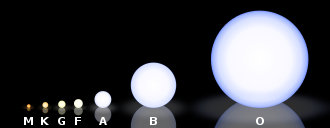šłĽÁ≥ĽŚąóśėüšłĽÁ≥ĽŚąóśėü[1] („Āó„āÖ„ĀĎ„ĀĄ„āĆ„Ā§„Āõ„ĀĄ„ÄĀŤčĪ: main sequence star[1]) „Ā®„ĀĮ„ÄĀśĀíśėü„ĀģśúČŚäĻśł©Śļ¶„Ā®śėé„āč„Āē„āíÁ§ļ„Āó„ĀüŚõ≥„Āß„Āā„āč„Éė„Éę„ÉĄ„ā∑„É•„Éó„Éę„É≥„āį„ÉĽ„É©„ÉÉ„āĽ„ÉęŚõ≥ (HRŚõ≥) šłä„Āß„ÄĀŚ∑¶šłäÔľąśėé„āč„ĀŹťęėśł©ÔľČ„Āč„āČŚõ≥„ĀģŚŹ≥šłčÔľąśöó„ĀŹšĹéśł©ÔľČ„Āꌼ∂„Ā≥„āčÁ∑ö„Āß„Āā„āčšłĽÁ≥ĽŚąó (ŤčĪ: main sequence) „ĀęšĹćÁĹģ„Āô„āčśĀíśėü„āí„ĀĄ„ĀÜ[2]„ÄāÁüģśėü„Ā®„āā„ĀĄ„ĀÜ[3]„Äā śėüťĖďÁČ©Ť≥™„ĀĆťõÜ„Āĺ„Ā£„Ā¶ŚĹĘśąź„Āē„āĆ„ĀüśĀíśėü„Āß„ĀĮ„ÄĀťęėŚĮÜŚļ¶„Āģś†ł„ĀßśįīÁī†„Āč„āČ„Éė„É™„ā¶„Ɇ„ā팟ąśąź„Āô„ā蜆łŤě挟ą„ĀĆŚßč„Āĺ„āä„ÄĀÁÜĪ„ā®„Éć„Éę„āģ„Éľ„ĀĆÁĒüśąź„Āē„āĆ„āč„ÄāśĀíśėü„ĀģšłÄÁĒü„Āę„Āä„ĀĎ„āč„Āď„ĀģśģĶťöé„Āß„ĀĮ„ÄĀśĀíśėü„ĀĮHRŚõ≥šłä„ĀģšłĽÁ≥ĽŚąó„ĀęšĹćÁĹģ„Āô„āč„Āď„Ā®„Āę„Ā™„āč„ÄāšłĽÁ≥ĽŚąóŚÜÖ„Āß„ĀģšĹćÁĹģ„ĀĮšłĽ„ĀęśĀíśėü„ĀģŤ≥™ťáŹ„ĀßśĪļ„Āĺ„āč„ĀĆ„ÄĀŚĆĖŚ≠¶ÁĶĄśąź„Ā®ŚĻīťĹĘ„Āę„āāšĺĚŚ≠ė„Āô„āč„ÄāšłĽÁ≥ĽŚąóśėü„Āģś†ł„ĀĮťĚôśįīŚúߌĻ≥Ť°°„ĀģÁä∂śÖč„Āę„Āā„āä„ÄĀťęėśł©„Āģś†ł„Āę„āą„ā茧ĖŚźĎ„Āć„ĀģÁÜĪÁöĄ„Ā™Śúߌäõ (ś≠£ÁĘļ„Āę„ĀĮŚúߌäõŚčĺťÖćŚäõ) „Ā®„ÄĀŚ§ĖŚĪ§„ĀģŚÜÖŚźĎ„Āć„ĀģťáćŚäõ„ĀĆťá£„ā䌟ą„Ā£„Ā¶„ĀĄ„āč„Äāś†łŤě挟ą„Āę„āą„āč„ā®„Éć„Éę„āģ„ÉľÁĒüśąźÁéá„ĀĮśł©Śļ¶„Ā®Śúߌäõ„Āꌾ∑„ĀŹšĺĚŚ≠ė„Āó„Ā¶„Āä„āä„ÄĀ„Āď„āĆ„ĀĆ„Āď„Āģťá£„ā䌟ą„ĀĄ„āíÁ∂≠śĆĀ„Āô„āč„Āģ„āíŚä©„ĀĎ„Ā¶„ĀĄ„āč„Äāś†ł„ĀßÁĒüśąź„Āē„āĆ„Āü„ā®„Éć„Éę„āģ„Éľ„ĀĮŤ°®ťĚĘ„Āł„Ā®šľĚťĀĒ„Āó„ÄĀŚÖČÁźÉ„Āč„āČśĒĺŚįĄ„Āē„āĆ„āč„ÄāšłĽÁ≥ĽŚąóśėüŚÜ֝ɮ„Āß„Āģ„ā®„Éć„Éę„āģ„Éľ„ĀĮśĒĺŚįĄ„āā„Āó„ĀŹ„ĀĮŚĮĺśĶĀ„Āę„āą„Ā£„Ā¶šľĚťĀĒ„Āē„āĆ„ÄĀŚĺĆŤÄÖ„ĀĮśł©Śļ¶ŚčĺťÖć„ĀƜĕ„Ā™ť†ėŚüü„ĀčšłćťÄŹśėéŚļ¶„ĀĆťęė„ĀĄť†ėŚüü„ÄĀ„āā„Āó„ĀŹ„ĀĮ„ĀĚ„Āģšł°śĖĻ„ĀĆśļÄ„Āü„Āē„āĆ„Ā¶„ĀĄ„ā蝆ėŚüü„ĀßÁôļÁĒü„Āô„āč„Äā šłĽÁ≥ĽŚąó„ĀĮ„ÄĀśĀíśėü„ĀĆ„ā®„Éć„Éę„āģ„Éľ„āíÁĒüśąź„Āô„āčšłĽŤ¶Ā„Ā™ťĀéÁ®č„ĀģťĀē„ĀĄ„ĀęŚüļ„Ā•„ĀĄ„Ā¶šłäťÉ®„Ā®šłčťÉ®„Āꌹ܄ĀĎ„āČ„āĆ„āč„Āď„Ā®„āā„Āā„āč„ÄāŚ§™ťôĹŤ≥™ťáŹ„Āģ1.5ŚÄć (1.5 M‚ėČ) „āą„ā䍼ńĀĄśĀíśėü„Āģšł≠ŚŅɝɮ„Āß„ĀĮ„ÄĀśįīÁī†„Āč„āČ„Éė„É™„ā¶„Ɇ„ĀĆŚźąśąź„Āē„āĆ„āčťĀéÁ®č„ĀĮšłĽ„ĀęťôĹŚ≠ź-ťôĹŚ≠źťÄ£ťéĖŚŹćŚŅú„Āƌ憄āĀ„Ā¶„ĀĄ„āč„Äā„Āď„ĀģŤ≥™ťáŹ„āíŤ∂Ö„Āą„āč„Ā®„ÄĀśįīÁī†„Āč„āČ„Éė„É™„ā¶„Ɇ„ā팟ąśąź„Āô„āčťĀéÁ®č„Āģšł≠ťĖď„ĀęÁā≠Áī†„ÄĀÁ™íÁī†„ÄĀťÖłÁī†ŚéüŚ≠ź„ĀĆťĖĘšłé„Āô„āčCNO„āĶ„ā§„āĮ„Éę„ĀĆšłĽ„Ā®„Ā™„āč„Äā2Ś§™ťôĹŤ≥™ťáŹ„āą„āäťáć„ĀĄšłĽÁ≥ĽŚąóśėü„Āß„ĀĮś†ł„ĀߌĮĺśĶĀ„ĀĆÁôļÁĒü„Āó„ÄĀÁĒüśąź„Āē„āĆ„Āü„Éė„É™„ā¶„Ɇ„āíśíĻśčĆ„Āó„ÄĀśįīÁī†ś†łŤě挟ą„ĀĆÁôļÁĒü„Āô„āč„Āü„āĀ„ĀęŚŅÖŤ¶Ā„Ā™ÁáÉśĖô„āíšĺõÁĶ¶„Āô„āčŚÉć„Āć„āíśěú„Āü„Āô„Äā„Āď„āĆ„āą„āä„āāŤĽĹ„ĀĄšłĽÁ≥ĽŚąóśėü„Āß„ĀĮ„ÄĀś†ł„ĀģŚ§ĖŚĀī„Āę„ĀĮśĒĺŚįĄ„Āß„ā®„Éć„Éę„āģ„Éľ„ĀĆťĀč„Āį„āĆ„āčśĒĺŚįĄŚĪ§„ĀĆŚļÉ„ĀĆ„āä„ÄĀŤ°®ťĚĘšĽėŤŅĎ„ĀęŚĮĺśĶĀŚĪ§„ĀĆÁôļťĀĒ„Āô„āč„ÄāśĀíśėü„ĀģŤ≥™ťáŹ„ĀĆŚįŹ„Āē„ĀŹ„Ā™„āč„Āę„Ā§„āĆ„ÄĀŚĮĺśĶĀ„ā®„É≥„Éô„É≠„Éľ„Éó„āíŚĹĘśąź„Āô„āčśĀíśėü„ĀģŚČ≤Śźą„ĀĮÁĚÄŚģü„ĀęŚĘóŚä†„Āô„āč„Äā0.4 M‚ėČ śú™śļÄ„ĀģšłĽÁ≥ĽŚąóśėü„ĀĮ„ÄĀŚÜ֝ɮŚÖ®šĹď„ĀĆŚĮĺśĶĀť†ėŚüü„Ā®„Ā™„āč„Äāś†ł„Āß„ĀģŚĮĺśĶĀ„ĀĆÁôļÁĒü„Āó„Ā™„ĀĄŚ†īŚźą„ÄĀśįīÁī†„ĀģŚ§ĖŚĪ§„ĀęŚõ≤„Āĺ„āĆ„Āü„Éė„É™„ā¶„ɆŤĪäŚĮĆ„Ā™ś†ł„ĀĆÁôļťĀĒ„Āô„āč„Āď„Ā®„Āę„Ā™„āč„Äā šłÄŤą¨„Āę„ÄĀťáć„ĀĄśĀíśėü„ĀĽ„Ā©šłĽÁ≥ĽŚąó„ĀęÁēô„Āĺ„āčśôāťĖď„ĀĮÁü≠„ĀŹ„Ā™„āč„Äā„Ā§„Āĺ„āäšłĽÁ≥ĽŚąóśėü„Ā®„Āó„Ā¶„ĀģŚĮŅŚĎĹ„ĀĆÁü≠„ĀŹ„Ā™„āč„ÄāśĀíśėü„Āģś†ł„Āę„Āä„ĀĎ„ā蜆łŤě挟ą„ĀęšĹŅÁĒ®ŚŹĮŤÉĹ„Ā™śįīÁī†„ĀĆśěĮśłá„Āó„ĀüŚĺĆ„ÄĀśĀíśėü„ĀĮHRŚõ≥šłä„ĀßšłĽÁ≥ĽŚąó„Āč„āČťõĘ„āĆ„ÄĀŤ∂ÖŚ∑®śėü„āĄŤĶ§ŤČ≤Ś∑®śėü„Āł„ÄĀ„Āā„āč„ĀĄ„ĀĮÁõīśé•ÁôĹŤČ≤Áüģśėü„Āł„Ā®ťÄ≤ŚĆĖ„Āô„āč„Äā ś≠īŚŹ≤  20šłĖÁīÄŚąĚť†≠„Āę„Ā™„āč„Ā®„ÄĀśĀíśėü„ĀģŚěč„Ā®Ť∑ĚťõĘ„ĀęťĖĘ„Āô„āčśÉÖŚ†Ī„ĀĆ„āą„āäŚģĻśėď„Āꌹ܄Āč„āč„āą„ĀÜ„Āę„Ā™„Ā£„Āü„ÄāśĀíśėü„Āģ„āĻ„Éö„āĮ„Éą„Éę„ĀĮÁč¨ÁČĻ„ĀģÁČĻŚĺī„āíśĆĀ„Ā§„Āď„Ā®„ĀĆÁ§ļ„Āē„āĆ„ÄĀ„ĀĚ„āĆ„ĀęŚüļ„Ā•„ĀĄ„Ā¶śĀíśėü„ā팹ܝ°ě„Āô„āč„Āď„Ā®„ĀĆŚŹĮŤÉĹ„Āę„Ā™„Ā£„Āü„Äā„ÉŹ„Éľ„Éź„Éľ„ÉČŚ§ßŚ≠¶Ś§©śĖጏį„Āģ„āĘ„Éč„Éľ„ÉĽ„āł„É£„É≥„Éó„ÉĽ„ā≠„É£„Éé„É≥„Ā®„ā®„ÉČ„ÉĮ„Éľ„ÉČ„ÉĽ„ÉĒ„ÉÉ„āę„É™„É≥„āį„ĀĮ„ÄĀÁŹĺŚú®„Āß„ĀĮ„ÉŹ„Éľ„Éź„Éľ„ÉČŚěč„Ā®„Āó„Ā¶Áü•„āČ„āĆ„āč„āĻ„Éö„āĮ„Éą„Éę„ĀęŚüļ„Ā•„ĀŹśĀíśėü„ĀģŚąÜť°ěś≥ē„āíÁĘļÁęč„Āó„ÄĀ„Āď„āĆ„ĀĮ„ÄéHarvard Annals„ÄŹ„Āę„Āä„ĀĄ„Ā¶1901ŚĻī„ĀęŚáļÁČą„Āē„āĆ„Āü[5]„Äā „ÉĚ„ÉĄ„ÉĄɆ„Āß„ĀĮ1906ŚĻī„Āę„ÄĀ„Éá„É≥„Éě„Éľ„āĮšļļŚ§©śĖáŚ≠¶ŤÄÖ„Āģ„āĘ„ā§„Éä„Éľ„ÉĽ„Éė„Éę„ÉĄ„ā∑„É•„Éó„Éę„É≥„āį„ĀĆ„ÄĀśúÄ„āāŤĶ§„ĀĄťÉ®ť°ě„ĀģśĀíśėü („ÉŹ„Éľ„Éź„Éľ„ÉČŚěč„ĀģŚąÜť°ě„Āß„ĀĮ K „Ā® M Śěč„Āꌹܝ°ě„Āē„āĆ„āč„āā„Āģ) „ĀĮ2„Ā§„ĀģÁēį„Ā™„āč„āį„Éę„Éľ„Éó„Āꌹ܌Č≤„Āß„Āć„āč„Āď„Ā®„Āęśįó„ĀĆšĽė„ĀĄ„Āü„Äā„Āď„āĆ„āČ„ĀģśĀíśėü„ĀĮŚ§™ťôĹ„āą„āä„Āö„Ā£„Ā®śėé„āč„ĀĄ„Āč„ÄĀ„Āā„āč„ĀĄ„ĀĮ„Āö„Ā£„Ā®śöó„ĀĄ„Āč„Āģ„Ā©„Ā°„āČ„Āč„Āß„Āā„Ā£„Āü„Äā„Āď„āĆ„āČ„Āģ„āį„Éę„Éľ„Éó„āíŚĆļŚą•„Āô„āč„Āü„āĀ„ÄĀ„Éė„Éę„ÉĄ„ā∑„É•„Éó„Éę„É≥„āį„ĀĮ„ÄĆŚ∑®śėü„Äć(giant stars) „Ā®„ÄĆÁüģśėü„Äć(dwarf stars) „Ā®ŚĎľ„āď„Ā†„ÄāÁŅĆŚĻī„ÄĀŚĹľ„ĀĮśėüŚõ£„ĀģÁ†ĒÁ©∂„āíťĖčŚßč„Āó„Āü„ÄāśėüŚõ£„Āß„ĀĮ„ÄĀ„ĀĽ„ĀľŚźĆ„ĀėŤ∑ĚťõĘ„Āꌧöśēį„ĀģśĀíśėü„ĀĆťõÜ„Āĺ„Ā£„Ā¶Ś≠ėŚú®„Āó„Ā¶„ĀĄ„āč„ÄāŚĹľ„ĀĮśėüŚõ£ŚÜÖ„ĀģśĀíśėü„ĀģŤČ≤śĆáśēį„Ā®ŚÖČŚļ¶„ā퍰®„Āó„ĀüśúÄŚąĚ„ĀģŚõ≥„āíÁôļŤ°®„Āó„Āü„Äā„ĀĚ„ĀģŚõ≥„Āß„ĀĮśĀíśėü„ĀĮť°ēŤĎó„ĀßťÄ£Á∂öÁöĄ„Ā™Á≥ĽŚąó„āíŚĹĘśąź„Āó„Ā¶„Āä„āä„ÄĀŚĹľ„ĀĮ„Āď„āĆ„āí„ÄĆšłĽÁ≥ĽŚąó„Äć„Ā®ŚĎĹŚźć„Āó„Āü[2]„Äā „Éó„É™„É≥„āĻ„Éą„É≥Ś§ßŚ≠¶„Āß„ĀĮ„ÄĀ„Éė„É≥„É™„Éľ„ÉĽ„Éé„É™„āĻ„ÉĽ„É©„ÉÉ„āĽ„Éę„ĀĆŚźĆśßė„ĀģÁ†ĒÁ©∂„āíÁ∂ôÁ∂ö„Āó„Ā¶„ĀĄ„Āü„ÄāŚĹľ„ĀĮśĀíśėü„Āģ„āĻ„Éö„āĮ„Éą„Éꌹܝ°ě„Ā®„ÄĀśĀíśėü„Āĺ„Āß„ĀģŤ∑ĚťõĘ„ĀģŤ£úś≠£„āí„Āč„ĀĎ„ĀüŚģüťöõ„Āģśėé„āč„Āē„ÄĀ„Ā§„Āĺ„āäÁĶ∂ŚĮĺÁ≠ČÁīö„Ā®„ĀģťĖď„Āꍶč„āČ„āĆ„āčťĖĘšŅā„Āę„Ā§„ĀĄ„Ā¶Á†ĒÁ©∂„ā퍰ƄĀ£„Ā¶„ĀĄ„Āü„Äā„Āď„ĀģÁ†ĒÁ©∂„Āģ„Āü„āĀ„ÄĀŚĹľ„ĀĮšŅ°ť†ľ„Āß„Āć„āčÁ≤ĺŚļ¶„Āߍ¶ĖŚ∑ģ„ĀĆśł¨Śģö„Āē„āĆ„Ā¶„Āä„āä„ÄĀ„ĀĚ„ĀģŚ§ö„ĀŹ„ĀĆ„ÉŹ„Éľ„Éź„Éľ„ÉČŚěč„ĀģŚąÜť°ě„ĀĆŤ°Ć„āŹ„āĆ„Ā¶„ĀĄ„ĀüśĀíśėü„āíÁĒ®„ĀĄ„Āü„ÄāŚĹľ„ĀĮ„Āď„āĆ„āČ„ĀģśĀíśėü„Āģ„āĻ„Éö„āĮ„Éą„ÉęŚěč„Ā®ÁĶ∂ŚĮĺÁ≠ČÁīö„āí„āį„É©„Éē„Āꍰ®„Āó„Āüťöõ„ÄĀÁüģśėü„ĀĆśėéÁĘļ„Ā™ťĖĘšŅā„ĀęŚĺď„ĀÜ„Āď„Ā®„āíÁôļŤ¶č„Āó„Āü„Äā„Āď„āĆ„Āę„āą„āä„ÄĀÁüģśėü„ĀģÁúü„Āģśėé„āč„Āē„ā팶•ŚĹď„Ā™Á≤ĺŚļ¶„Āßšļąśł¨„Āô„āč„Āď„Ā®„ĀĆŚŹĮŤÉĹ„Ā®„Ā™„Ā£„Āü[6]„Äā „Éė„Éę„ÉĄ„ā∑„É•„Éó„Éę„É≥„āį„Āę„āą„Ā£„Ā¶Ť¶≥śł¨„Āē„āĆ„ĀüŤĶ§„ĀĄśĀíśėü„Āģ„ĀÜ„Ā°„ÄĀÁüģśėü„ĀĮ„É©„ÉÉ„āĽ„Éę„Āę„āą„Ā£„Ā¶ÁôļŤ¶č„Āē„āĆ„Āü„āĻ„Éö„āĮ„Éą„Éę„Ā®ŚÖČŚļ¶„ĀģťĖĘšŅā„ĀęŚĺď„ĀÜ„Äā„Āó„Āč„ĀóŚ∑®śėü„ĀĮÁüģśėü„āą„āä„āāťĀ•„Āč„Āęśėé„āč„ĀŹ„ÄĀŚźĆ„ĀėťĖĘšŅā„Āę„ĀĮŚĺď„āŹ„Ā™„Āč„Ā£„Āü„Äā„É©„ÉÉ„āĽ„Éę„ĀĮ„ÄĆŚ∑®śėü„ĀĮšĹéŚĮÜŚļ¶„Āß„Āā„āč„Ā茧߄Āć„Ā™Ť°®ťĚĘŤľĚŚļ¶„āíśĆĀ„Ā£„Ā¶„ĀĄ„āč„Āč„Āß„Āā„āč„ĀĮ„Āö„Āß„Āā„āä„ÄĀÁüģśėü„Āę„ĀĮ„ĀĚ„ĀģťÄÜ„ĀĆŚĹď„Ā¶„ĀĮ„Āĺ„āč„Äć„Ā®śŹźŚĒĪ„Āó„Āü[6]„Äā„Āĺ„ĀüHRŚõ≥šłä„Āģśõ≤Á∑ö„ĀĮ„ÄĀśöó„ĀĄÁôĹŤČ≤Áüģśėü„ĀĮťĚ쌳ł„Āę„āŹ„Āö„Āč„Āó„ĀčŚ≠ėŚú®„Āó„Ā¶„ĀĄ„Ā™„ĀĄ„Āď„Ā®„āāÁ§ļ„Āó„Āü[6]„Äā śĀíśėü„ĀģŚÖČŚļ¶„Ā®„āĻ„Éö„āĮ„Éą„ÉęŚěč„āíÁ§ļ„Āó„ĀüŚõ≥„āí„Éė„Éę„ÉĄ„ā∑„É•„Éó„Éę„É≥„āį„ÉĽ„É©„ÉÉ„āĽ„ÉęŚõ≥„Ā®ŚĎľ„āď„Ā†„Āģ„ĀĮ„Éô„É≥„āĮ„Éą„ÉĽ„āĻ„Éą„ɨ„Éľ„Ɇ„āį„ɨ„É≥„Āß„Āā„āä„ÄĀ1933ŚĻī„Āģ„Āď„Ā®„Āß„Āā„Ā£„Āü[7]„Äā„Āď„ĀģŚźćÁßį„ĀĮ„ÄĀ20šłĖÁīÄŚąĚť†≠„Āę„Éė„Éę„ÉĄ„ā∑„É•„Éó„Éę„É≥„āį„Ā®„É©„ÉÉ„āĽ„Éę„Āģšł°Śźć„ĀĆ„ĀĚ„āĆ„Āě„āĆÁč¨Áęč„Āę„Āď„ĀģśäÄŤ°ď„āíÁĒü„ĀŅŚáļ„Āó„Āü„Āď„Ā®„ā팏ćśė†„Āó„Ā¶„ĀĄ„āč[2]„Äā 1930ŚĻīšĽ£„ĀęśĀíśėü„ĀģťÄ≤ŚĆĖ„ÉĘ„Éá„Éę„ĀĆÁôļŚĪē„Āô„āč„Āę„Ā§„āĆ„ÄĀšłÄśßė„Ā™ŚĆĖŚ≠¶ÁĶĄśąź„āíśĆĀ„Ā§śĀíśėü„ĀģŚ†īŚźą„ÄĀśĀíśėü„ĀģŤ≥™ťáŹ„Ā®„ĀĚ„ĀģŚÖČŚļ¶„ÄĀ„Āä„āą„Ā≥ŚćäŚĺĄ„ĀģťĖď„ĀęťĖĘšŅā„ĀĆ„Āā„āč„Āď„Ā®„ĀĆŚąÜ„Āč„Ā£„Ā¶„Āć„Āü„Äā„Āď„āĆ„ĀĮ„Āô„Ā™„āŹ„Ā°„ÄĀŤ≥™ťáŹ„Ā®ÁĶĄśąź„ĀĆŚąÜ„Āč„Ā£„Ā¶„ĀĄ„āĆ„Āį„ÄĀśĀíśėü„ĀģŚćäŚĺĄ„Ā®ŚÖČŚļ¶„ā횳ĜĄŹ„ĀęŚģö„āĀ„āčŤß£„ĀĆŚ≠ėŚú®„Āô„āč„Ā®„ĀĄ„ĀÜ„Āď„Ā®„ā휥ŹŚĎ≥„Āô„āč„Äā„Āď„ĀģťĖĘšŅā„ĀĮ„ÄĀ„ÉŹ„ā§„É≥„É™„Éí„ÉĽ„Éē„ā©„Éľ„āĮ„Éą„Ā®„É©„ÉÉ„āĽ„Éę„Āę„Ā°„Ā™„āď„ĀߌĎĹŚźć„Āē„āĆ„Āü„É©„ÉÉ„āĽ„Éę„ÉĽ„Éē„ā©„āĮ„ÉąŚģöÁźÜ[8]„Ā®„Āó„Ā¶Áü•„āČ„āĆ„Ā¶„ĀĄ„āč„Äā„Āď„ĀģŚģöÁźÜ„Āę„āą„āä„ÄĀśĀíśėü„ĀģŚĆĖŚ≠¶ÁĶĄśąź„Ā®„ĀĚ„ĀģšłĽÁ≥ĽŚąóšłä„Āß„ĀģšĹćÁĹģ„ĀĆŚąÜ„Āč„Ā£„Ā¶„ĀĄ„ā茆īŚźą„ÄĀ„ĀĚ„ĀģśĀíśėü„ĀģŤ≥™ťáŹ„Ā®ŚćäŚĺĄ„āāŚąÜ„Āč„āč„Āď„Ā®„Āę„Ā™„āč„Äā„Āü„Ā†„ĀóŚĺĆŚĻī„Āę„Ā™„Ā£„Ā¶„ÄĀšłÄśßė„Āß„ĀĮ„Ā™„ĀĄÁĶĄśąź„āíśĆĀ„Ā§śĀíśėü„ĀģŚ†īŚźą„ĀĮ„Āď„ĀģŚģöÁźÜ„ĀĆŚĻ匹܄ĀčÁ†ī„āĆ„āč„Āď„Ā®„ĀĆŚą§śėé„Āó„Ā¶„ĀĄ„āč[9]„Äā śĀíśėü„Āģ„āĻ„Éö„āĮ„Éą„Éꌹܝ°ě„ĀģśĒĻŚģö„Āē„āĆ„Āü„āĻ„ā≠„Éľ„Ɇ„ĀĮ„ā¶„ā£„É™„āʄɆ„ÉĽ„ā¶„ā£„Éę„āĹ„É≥„ÉĽ„ÉĘ„Éľ„ā¨„É≥„Ā® Philip Childs Keenan „Āę„āą„Ā£„Ā¶1943ŚĻī„ĀęÁôļŤ°®„Āē„āĆ[10]„ÄĀ„Āď„āĆ„ĀĮšł°ŤÄÖ„Āģ„ā§„Éč„ā∑„É£„Éę„ā팏Ė„Ā£„Ā¶„ÄĆMKŚąÜť°ě„Äć[11]„Ā®ŚĎľ„Āį„āĆ„Ā¶„ĀĄ„āč„ÄāMKŚąÜť°ě„Āß„ĀĮ„ÄĀ„ĀĚ„āĆ„Āě„āĆ„ĀģśĀíśėü„ĀęŚĮĺ„Āó„Ā¶„ÉŹ„Éľ„Éź„Éľ„ÉČŚěč„ĀęŚüļ„Ā•„ĀŹ„āĻ„Éö„āĮ„Éą„ÉęŚěč„Ā®„ÄĀŚÖČŚļ¶ťöéÁīö„āíŚČ≤„āäŚĹď„Ā¶„āč„Äā„ÉŹ„Éľ„Éź„Éľ„ÉČŚěč„ĀģŚąÜť°ě„Āß„ĀĮ„ÄĀ„āĻ„Éö„āĮ„Éą„Éę„Ā®śł©Śļ¶„ĀģťĖĘšŅā„ĀĆÁü•„āČ„āĆ„āč„āą„āäŚČć„Āę„ÄĀśįīÁī†„Āģ„āĻ„Éö„āĮ„Éą„ÉęÁ∑ö„ĀģŚľ∑Śļ¶„ĀęŚüļ„Ā•„ĀĄ„Ā¶Áēį„Ā™„āčśĖáŚ≠ó„ĀĆŚČ≤„āäŚĹď„Ā¶„āČ„āĆ„Ā¶„ĀĄ„Āü„Äā„Āď„āĆ„āíśĀíśėü„Āģśł©Śļ¶ť†Ü„Āęšł¶„ĀĻśõŅ„Āą„ÄĀ„Āē„āČ„Āęťá捧á„Āó„ĀüŚěč„āíťô§„ĀĄ„ĀüÁĶźśěú„ÄĀśł©Śļ¶„ĀĆťęė„ĀĄťĚí„Āč„āČŤĶ§„Āģť†ÜÁē™„ĀĮ„ÄĀO„ÄĀB„ÄĀA„ÄĀF„ÄĀG„ÄĀK„ÄĀM „Ā®„Ā™„Ā£„Āü„Äā„Āĺ„ĀüMKŚěč„Āß„ĀģŚÖČŚļ¶ťöéÁīö„ĀĮśėé„āč„ĀĄť†Ü„Āę„É≠„Éľ„ÉěśēįŚ≠ó„Āß I „Āč„āČ V „Āĺ„Āß„ĀĆŚČ≤„āäśĆĮ„āČ„āĆ„Āü„ÄāŚÖČŚļ¶ťöéÁīö„Āß V „ĀęŚĪě„Āô„āč„āā„Āģ„ĀĆšłĽÁ≥ĽŚąó„ĀęŚĪě„Āô„āčśĀíśėü„Āß„Āā„āč[12]„Äā ŚĹĘśąź„Ā®ťÄ≤ŚĆĖ‚Ü퍩≥Áīį„ĀĮ„ÄĆśėüŚĹĘśąź„Äć„ÄĀ„ÄĆŚéüŚßčśėü„Äć„ÄĀ„ÄĆŚČćšłĽÁ≥ĽŚąóśėü„Äć„ÄĀ„Āä„āą„Ā≥„ÄĆśĀíśėüťÄ≤ŚĆĖŤęĖ„Äć„ā팏āÁÖß
ŚĪÄśČÄÁöĄ„Ā™śėüťĖďÁČ©Ť≥™šł≠„ĀģŚ∑®Ś§ßŚąÜŚ≠źťõ≤„ĀģŚī©Ś£ä„Āę„āą„Ā£„Ā¶ŚéüŚßčśėü„ĀĆŚĹĘśąź„Āē„āĆ„āčťöõ„ÄĀŚąĚśúü„ĀģÁĶĄśąź„ĀĮŚÖ®šĹď„ĀßšłÄśßė„Āß„Āā„āä„ÄĀŚźę„Āĺ„āĆ„Ā¶„ĀĄ„āčÁČ©Ť≥™„ĀĮŤ≥™ťáŹśĮĒ„Āß„Āä„āą„ĀĚ 70% „ĀĆśįīÁī†„ÄĀ28% „ĀĆ„Éė„É™„ā¶„Ɇ„ÄĀ„ĀĚ„ĀģšĽĖ„ĀģŚÖÉÁī†„ĀĮśģč„āä„ĀģŚĺģťáŹ„āíŚć†„āĀ„Ā¶„ĀĄ„āč[13]„ÄāśĀíśėü„ĀģŚąĚśúüŤ≥™ťáŹ„ĀĮ„ÄĀŚąÜŚ≠źťõ≤šł≠„ĀģŚĪÄśČÄÁöĄ„Ā™śĚ°šĽ∂„ĀęšĺĚŚ≠ė„Āô„āč„ÄāśĖį„Āó„ĀŹŚĹĘśąź„Āē„āĆ„āčśĀíśėü„ĀģŤ≥™ťáŹŚąÜŚłÉ„ĀĮ„ÄĀŚąĚśúüŤ≥™ťáŹťĖĘśēį„Āę„āą„Ā£„Ā¶ÁĶĆť®ďÁöĄ„ĀꍮėŤŅį„Āē„āĆ„āč[14]„ÄāŚąĚśúü„ĀģŚąÜŚ≠źťõ≤„ĀģŚī©Ś£ä„ĀģśúÄšł≠„ÄĀ„Āď„ĀģŚČćšłĽÁ≥ĽŚąóśėü„ĀĮťáćŚäõŚŹéÁłģ„Āę„āą„Ā£„Ā¶„ā®„Éć„Éę„āģ„Éľ„āíŤß£śĒĺ„Āô„āč„Äāśėü„Āģšł≠ŚŅɝɮ„ĀĆťĀ©Śąá„Ā™ŚĮÜŚļ¶„ĀęťĀĒ„Āô„āč„Ā®„ÄĀśįīÁī†„āí„Éė„É™„ā¶„Ɇ„ĀꌧȜŹõ„Āô„ā蜆łŤě挟ąŚŹćŚŅú„Āę„āą„Ā£„Ā¶ś†ł„Āß„Āģ„ā®„Éć„Éę„āģ„ÉľÁĒüśąź„ĀĆŚßč„Āĺ„āč[12]„Äā śįīÁī†ś†łŤě挟ą„ĀĆšłĽŤ¶Ā„Ā™„ā®„Éć„Éę„āģ„ÉľÁĒüśąźťĀéÁ®č„Ā®„Ā™„āä„ÄĀťáćŚäõŚŹéÁłģ„Āę„āą„Ā£„Ā¶Ťß£śĒĺ„Āē„āĆ„āč„ā®„Éć„Éę„āģ„Éľ„ĀģŤ∂ÖťĀé„ĀĆ„Ā™„ĀŹ„Ā™„āč„Ā®[15]„ÄĀśėü„ĀĮHRŚõ≥šłä„ĀßšłĽÁ≥ĽŚąó„Ā®ŚĎľ„Āį„āĆ„āčśõ≤Á∑ö„Āģšłä„ĀęśĚ•„āč„ÄāŚ§©śĖáŚ≠¶ŤÄÖ„ĀĮ„Āď„ĀģśģĶťöé„Āģšļč„āí„Āó„Āį„Āó„Āį„ÄĆťõ∂ŚĻīťĹĘšłĽÁ≥ĽŚąó„Äć[16]„āĄ„ÄĆťõ∂ś≠≥šłĽÁ≥ĽŚąó„Äć[17] (ŤčĪ: zero age main sequence, ZAMS) „Ā®ŚĎľ„Ā≥[18][19]„ÄĀZAMS šłä„Āę„Āā„āčśĀíśėü„ĀĮ„ÄĆťõ∂ŚĻīťĹĘšłĽÁ≥ĽŚąóśėü„Äć„āĄ„ÄĆťõ∂ś≠≥šłĽÁ≥ĽŚąóśėü„Äć„Ā®ŚĎľ„Āį„āĆ„āč[16][17]„ÄāZAMS „ĀĮ„ÄĀśĀíśėü„Āģś†ł„Āß„ĀģśįīÁī†ś†łŤě挟ąŚŹćŚŅú„Ā®śĒĺŚįĄ„Āę„āą„āč„ā®„Éć„Éę„āģ„Éľ„ĀģŚŹéśĒĮ„ĀĆŚąĚ„āĀ„Ā¶ťá£„ā䌟ą„Ā£„ĀüśģĶťöé„ĀęÁõłŚĹď„Āô„āč[16]„ÄāHRŚõ≥šłä„Āß„Āģ ZAMS „Āģśõ≤Á∑ö„ĀĮ„ÄĀśįīÁī†ś†łŤě挟ą„ĀĆŚßč„Āĺ„Ā£„ĀüśģĶťöé„Āß„ĀģśĀíśėü„ĀģÁČĻśÄß„ĀģśēįŚÄ§„ÉĘ„Éá„Éę„āíÁĒ®„ĀĄ„Ā¶Ť®ąÁģó„Āô„āč„Āď„Ā®„ĀĆ„Āß„Āć„āč„Äā„Āď„ĀģśôāÁāĻ„Āč„āČ„ÄĀśĀíśėü„Āģśėé„āč„Āē„Ā®Ť°®ťĚĘśł©Śļ¶„ĀĮŚÖłŚěčÁöĄ„Āę„ĀĮŚĻīťĹĘ„ĀĆŚĘóŚä†„Āô„āč„ĀęťÄ£„āĆ„Ā¶šłäśėá„Āô„āč[20]„Äā śĀíśėü„ĀĮśįīÁī†ś†łŤě挟ą„Āę„āą„ā䜆ł„Āę„Āā„āčśįīÁī†„ĀģŚ§ßťÉ®ŚąÜ„āíšĹŅ„ĀĄśěú„Āü„Āô„Āĺ„Āß„ĀĮ„ÄĀHRŚõ≥šłä„ĀßšłĽÁ≥ĽŚąó„ĀģŚąĚśúüšĹćÁĹģšĽėŤŅĎ„ĀęÁēô„Āĺ„āä„ÄĀ„ĀĚ„ĀģŚĺĆ„āą„āäśėé„āč„ĀĄśĀíśėü„Āł„Ā®ťÄ≤ŚĆĖ„Āô„āč„ÄāHRŚõ≥šłä„Āß„ĀĮ„ÄĀťÄ≤ŚĆĖ„Āô„āčśĀíśėü„ĀĮšłĽÁ≥ĽŚąó„ĀģŚŹ≥šłäśĖĻŚźĎ„ĀęÁ߼Śčē„Āô„āč„ÄāŚĺď„Ā£„Ā¶„ÄĀšłĽÁ≥ĽŚąó„ĀĮśĀíśėü„ĀģŚĮŅŚĎĹ„Āģ„ĀÜ„Ā°šłĽŤ¶Ā„Ā™śįīÁī†ÁáÉÁĄľ„ĀģśģĶťöé„ā퍰®„Āó„Ā¶„ĀĄ„āč„Āď„Ā®„Āę„Ā™„āč[12]„Äā ÁČĻŚĺīŚÖłŚěčÁöĄ„Ā™HRŚõ≥šłä„Āę„Āā„āčśĀíśėü„ĀģŚ§ßŚ§öśēį„ĀĮ„ÄĀšłĽÁ≥ĽŚąó„Āģśõ≤Á∑ö„Āęś≤Ņ„Ā£„ĀüšĹćÁĹģ„Āę„Āā„āč„ÄāśĀíśėü„Āģ„āĻ„Éö„āĮ„Éą„Éꌹܝ°ě„Ā®ŚÖČŚļ¶„ĀĮ„ÄĀś†ł„ĀßśįīÁī†ś†łŤě挟ą„āíŤĶ∑„Āď„Āó„Ā¶„ĀĄ„āčťôź„āä„ĀĮ„ÄĀŚįĎ„Ā™„ĀŹ„Ā®„āāÁ¨¨„āľ„É≠ŤŅĎšľľÁöĄ„Āę„ĀĮ„ĀĚ„ĀģśĀíśėü„ĀģŤ≥™ťáŹ„Āģ„ĀŅ„ĀęšĺĚŚ≠ė„Āô„āč„Äā„Āĺ„Āü„ĀĚ„ĀģÁä∂śÖč„ĀĮ„ĀĽ„Ā®„āď„Ā©ŚÖ®„Ā¶„ĀģśĀíśėü„ĀĆ„ĀĚ„Āģ„ÄĆśīĽÁôļ„Ā™„ÄćśīĽŚčē„ā퍰ƄĀÜśúüťĖď„ĀßÁ∂ôÁ∂ö„Āô„āč„Äā„ĀĚ„Āģ„Āü„āĀ„ÄĀHRŚõ≥šłä„Āß„ĀĮšłĽÁ≥ĽŚąó„Āģśõ≤Á∑ö„ĀĮť°ēŤĎó„Ā™„āā„Āģ„Ā®„Ā™„āč[21]„Äā śĀíśėü„Āģśł©Śļ¶„ĀĮ„ÄĀśĀíśėü„ĀģŚÖČÁźÉ„Āß„Āģ„Éó„É©„āļ„Éě„ĀģÁČ©ÁźÜÁöĄÁČĻŚĺī„Āł„ĀģŚäĻśěú„ā횼č„Āó„Ā¶„āĻ„Éö„āĮ„Éą„ÉęŚěč„āíśĪļŚģö„Āô„āč„Äāś≥Ęťē∑„ĀģťĖĘśēį„Ā®„Āó„Ā¶„ĀģśĀíśėü„Āģ„ā®„Éć„Éę„āģ„ÉľśĒĺŚįĄ„ĀĮ„ÄĀśł©Śļ¶„Ā®ÁĶĄśąź„Āģšł°śĖĻ„ĀęŚĹĪťüŅ„Āē„āĆ„āč„Äā„Āď„Āģ„ā®„Éć„Éę„āģ„ÉľŚąÜŚłÉ„Āģťá捶Ā„Ā™śĆáś®ô„Ā®„Ā™„āč„Āģ„ĀĮŤČ≤śĆáśēį„Āģ B-V „Āß„Āā„āä„ÄĀ„Āď„āĆ„ĀĮťĚí„ĀĄ„Éē„ā£„Éę„āŅ„Éľ (B) „Ā®Á∑Ď„ÄúťĽĄŤČ≤„Āģ„Éē„ā£„Éę„āŅ„Éľ (V) „āíťÄö„Āó„Ā¶śł¨Śģö„Āē„āĆ„ĀüśĀíśėü„ĀģÁ≠ČÁīö„ĀģŚ∑ģŚąÜ„Āč„āČŤ®ąÁģó„Āē„āĆ„āč„Äā„Āď„ĀģÁ≠ČÁīö„Āę„Āä„ĀĎ„āčťĀē„ĀĄ„Āč„āČśĀíśėü„Āģśł©Śļ¶„ĀĆśł¨Śģö„Āē„āĆ„āč„Äā Áüģśėü„Ā®„ĀĄ„ĀÜÁĒ®Ť™ěšłĽÁ≥ĽŚąóśėü„ĀĮÁüģśėü„Ā®ŚĎľ„Āį„āĆ„āč„ĀĆ[22][23]„ÄĀ„Āď„ĀģÁĒ®Ť™ě„Āę„ĀĮś≠īŚŹ≤ÁöĄ„Ā™ŚĀīťĚĘ„ĀĆ„Āā„āä„ÄĀ„Āĺ„Āü„ĀĄ„ĀŹ„āČ„ĀčÁīõ„āČ„āŹ„Āó„ĀĄ„āā„Āģ„Āß„Āā„āč„ÄāŤĶ§ŤČ≤Áüģśėü„ÄĀś©ôŤČ≤Áüģśėü„ÄĀťĽĄŤČ≤Áüģśėü„Ā®„ĀĄ„Ā£„Āü„āą„āäšĹéśł©„Ā™śĀíśėü„ĀĮ„ÄĀ„Āü„Āó„Āč„Āę„Āď„āĆ„āČ„ĀģŤČ≤„āíśĆĀ„Ā§šĽĖ„ĀģśĀíśėü„āą„āä„āāŚįŹ„Āē„ĀŹśöó„ĀĄ„Äā„Āó„Āč„Āó„ÄĀ„āą„āäťęėśł©„Ā™ťĚíŤČ≤„āĄÁôĹŤČ≤„ĀģśĀíśėü„Āß„ĀĮ„ÄĀ„ĀĄ„āŹ„āÜ„āč„ÄĆÁüģśėü„Äć„Ā®ŚĎľ„Āį„āĆ„āčšłĽÁ≥ĽŚąó„Āę„Āā„āčśĀíśėü„Ā®„ÄĀ„ÄĆŚ∑®śėü„Äć„Ā®ŚĎľ„Āį„āĆ„āčšłĽÁ≥ĽŚąó„Āč„āČŚ§Ė„āĆ„ĀüśĀíśėü„Ā®„ĀģťĖď„Āę„Āā„āč„āĶ„ā§„āļ„āĄśėé„āč„Āē„ĀģťĀē„ĀĄ„ĀĮŚįŹ„Āē„ĀĄ„āā„Āģ„Āę„Ā™„āč„ÄāśúÄ„āāťęėśł©„Ā™ťÉ®ť°ě„ĀģśĀíśėü„Āß„ĀĮ„Āď„ĀģťĀē„ĀĄ„ĀĮÁõīśé•ÁöĄ„Āę„ĀĮŤ¶≥śł¨„Āß„Āć„Ā™„ĀĄ„āā„Āģ„Ā®„Ā™„āč„Äā„Āď„Āģ„āą„ĀÜ„Ā™śĀíśėü„ĀģŚ†īŚźą„ÄĀÁüģśėü„ĀčŚ∑®śėü„Āč„ĀģŚą§śĖ≠„ĀĮ„ÄĀśĀíśėü„ĀĆšłĽÁ≥ĽŚąó„Āę„Āā„āč„Āč„Ā©„ĀÜ„Āč„āíÁ§ļ„Āô„āĻ„Éö„āĮ„Éą„ÉęÁ∑ö„ĀģťĀē„ĀĄ„Āč„āČŚą§śĖ≠„Āē„āĆ„āč„Äā„Āď„Āģ„āą„ĀÜ„ĀęťĚ쌳ł„Āęťęėśł©„Ā™šłĽÁ≥ĽŚąóśėü„ĀĮŚźĆÁ®čŚļ¶„Āģśł©Śļ¶„āíśĆĀ„Ā§„ÄĆŚ∑®śėü„Äć„Ā®ŚźĆÁ®čŚļ¶„Āģ„āĶ„ā§„āļ„Ā®śėé„āč„Āē„āíśĆĀ„Ā£„Ā¶„ĀĮ„ĀĄ„āč„āā„Āģ„Āģ„ÄĀ„Āó„Āį„Āó„Āį„ÄĆÁüģśėü„Äć„Ā®Áßį„Āē„āĆ„āč[24]„Äā šłĽÁ≥ĽŚąóśėü„āíśĆá„Āó„Ā¶„ÄĆÁüģśėü„Äć„Ā®„ĀĄ„ĀÜÁĒ®Ť™ě„āíÁĒ®„ĀĄ„āč„Āď„Ā®„ĀĮŚą•Á®ģ„ĀģÁīõ„āČ„āŹ„Āó„Āē„āāŚźę„āď„Āß„ĀĄ„āč„Äā„Ā™„Āú„Ā™„āČ„ÄĀšłĽÁ≥ĽŚąó„ĀęšĹćÁĹģ„Āó„Ā¶„ĀĄ„Ā™„ĀĄÁüģśėü„āāŚ≠ėŚú®„Āô„āč„Āč„āČ„Āß„Āā„āč„Äāšĺč„Āą„ĀįÁôĹŤČ≤Áüģśėü„ĀĮśĀíśėü„ĀĆ„ĀĚ„ĀģŚ§ĖŚĪ§„āíśĒĺŚáļ„Āó„ĀüŚĺĆ„Āęśģč„Āē„āĆ„ā蜆ł„Āģśģčť™ł„Āß„Āā„āä„ÄĀŚ§ß„Āć„Āē„ĀĮ„Āä„Āä„āą„ĀĚŚúįÁźÉÁ®čŚļ¶„Āß„ÄĀšłĽÁ≥ĽŚąóśėü„āą„āä„āā„Āö„Ā£„Ā®ŚįŹ„Āē„ĀĄ„ÄāÁôĹŤČ≤Áüģśėü„ĀĮŚ§ö„ĀŹ„ĀģšłĽÁ≥ĽŚąóśėü„ĀģťÄ≤ŚĆĖ„ĀģśúÄÁĶāśģĶťöé„Āß„Āā„āč[25]„Äā „ÉĎ„É©„É°„Éľ„āŅ śĀíśėü„ā흼íšĹď„Ā®ŚĎľ„Āį„āĆ„āčÁźÜśÉ≥ŚĆĖ„Āē„āĆ„Āü„ā®„Éć„Éę„āģ„ÉľśĒĺŚįĄšĹď„Ā®„Āó„Ā¶śČĪ„Ā£„ĀüŚ†īŚźą„ÄĀŚÖČŚļ¶ „Ā®ŚćäŚĺĄ „ĀĮ„ā∑„É•„ÉÜ„Éē„ā°„É≥Ծ̄Éú„Éę„ÉĄ„Éě„É≥„Āģś≥ēŚČá„Āę„āą„Ā£„Ā¶śúČŚäĻśł©Śļ¶ „Ā®šĽ•šłč„ĀģťĖĘšŅāŚľŹ„ĀßÁĶź„Ā≥šĽė„ĀĎ„āČ„āĆ„āč„Äā „Āď„Āď„Āß„ÄĀ „ĀĮ„ā∑„É•„ÉÜ„Éē„ā°„É≥=„Éú„Éę„ÉĄ„Éě„É≥Śģöśēį„Āß„Āā„āč„ÄāHRŚõ≥šłä„Āß„ĀģśĀíśėü„ĀģšĹćÁĹģ„ĀĮ„ĀĚ„ĀģśĀíśėü„Āģ„Āä„Āä„āą„ĀĚ„ĀģŚÖČŚļ¶„āíÁ§ļ„Āó„Ā¶„ĀĄ„āč„Āü„āĀ„ÄĀ„Āď„ĀģťĖĘšŅāŚľŹ„Āč„āČśĀíśėü„ĀģŚćäŚĺĄ„āíśé®Śģö„Āô„āč„Āď„Ā®„ĀĆ„Āß„Āć„āč[26]„Äā śĀíśėü„ĀģŤ≥™ťáŹ„ÄĀŚćäŚĺĄ„Ā®ŚÖČŚļ¶„ĀĮŚĮÜśé•„ĀęťĖĘťÄ£„Āó„Ā¶„Āä„āä„ÄĀ„ĀĚ„āĆ„Āě„āĆ„ĀģŚÄ§„ĀĮ3„Ā§„ĀģťĖĘšŅā„ĀߍŅĎšľľ„Āô„āč„Āď„Ā®„ĀĆ„Āß„Āć„āč„Äā1„Ā§Áõģ„ĀĮ„ā∑„É•„ÉÜ„Éē„ā°„É≥Ծ̄Éú„Éę„ÉĄ„Éě„É≥„Āģś≥ēŚČá„Āß„Āā„āä„ÄĀ„Āď„āĆ„ĀĮśĀíśėü„ĀģŚÖČŚļ¶„Ā®ŚćäŚĺĄ„ÄĀ„Āä„āą„Ā≥śúČŚäĻśł©Śļ¶„āíÁĶź„Ā≥šĽė„ĀĎ„āč„Äā2„Ā§Áõģ„ĀĮŤ≥™ťáŹŚÖČŚļ¶ťĖĘšŅā[27]„Āß„ÄĀśĀíśėü„ĀģŚÖČŚļ¶„Ā®Ť≥™ťáŹ„āíÁĶź„Ā≥šĽė„ĀĎ„āč„Äā3„Ā§Áõģ„ĀĮ„ÄĀśĀíśėü„ĀģŤ≥™ťáŹ„Ā®ŚćäŚĺĄ„ĀģťĖĘšŅā„ĀĮśĮĒšĺčťĖĘšŅā„ĀęŤŅĎ„ĀĄ„Ā®„ĀĄ„ĀÜ„āā„Āģ„Āß„Āā„āč„ÄāśĀíśėü„ĀģŤ≥™ťáŹ„ĀęŚĮĺ„Āô„āčŚćäŚĺĄ„ĀģśĮĒÁéá„ĀĮ„ÄĀś°Ā„Āę„Āó„Ā¶2.5ś°Ā„Āę„āŹ„Āü„āčŤ≥™ťáŹ„ĀģÁĮĄŚõ≤„Āß„āŹ„Āö„Āč3ŚÄć„Āó„ĀčŚĘóŚä†„Āó„Ā™„ĀĄ„ÄĀ„Ā§„Āĺ„āä„ĀĽ„ĀľśĮĒšĺčťĖĘšŅā„Āß„Āā„āč„Ā®„ĀĄ„ĀÜ„Āď„Ā®„ĀĆŚąÜ„Āč„Ā£„Ā¶„ĀĄ„āč„Äā„Āď„ĀģťĖĘšŅā„ĀĮśĀíśėü„ĀģŚÜ֝ɮśł©Śļ¶ „Āę„Āä„Āä„āÄ„Ā≠śĮĒšĺč„Āó„Ā¶„Āä„āä„ÄĀ„Āĺ„Āü„ĀĚ„Āģ„āÜ„Ā£„ĀŹ„āä„Ā®„Āó„ĀüŚĘóŚä†„ĀĮ„ÄĀśĀíśėüšł≠ŚŅɝɮ„Āß„Āģ„ā®„Éć„Éę„āģ„ÉľÁĒüśąźťÄüŚļ¶„ĀĆŚÜ֝ɮśł©Śļ¶„Āꌾ∑„ĀŹšĺĚŚ≠ė„Āô„āč„Ā®„ĀĄ„ĀÜšļčŚģü„ā팏ćśė†„Āó„Ā¶„ĀĄ„ā蚳ĜĖĻ„Āß„ÄĀŤ≥™ťáŹŚÖČŚļ¶ťĖĘšŅā„āíśļÄ„Āü„Āó„Ā¶„ĀĄ„āčŚŅÖŤ¶Ā„āā„Āā„āč„Äā„ĀĚ„Āģ„Āü„āĀ„ÄĀśł©Śļ¶„ĀĆťĚ쌳ł„Āęťęė„ĀĄ„Āč„ÄĀ„Āā„āč„ĀĄ„ĀĮťĚ쌳ł„ĀęšĹé„ĀĄŚ†īŚźą„ĀĮ„ÄĀśĀíśėü„ĀģšłćŚģČŚģöśÄß„ā팾ē„ĀćŤĶ∑„Āď„Āô„Äā „āą„āäŤČĮ„ĀĄŤŅĎšľľ„Ā®„Āó„Ā¶„ĀĮ„ÄĀŚćėšĹćŤ≥™ťáŹ„Āā„Āü„āä„Āģ„ā®„Éć„Éę„āģ„ÉľÁĒüśąźÁéá „ĀģťĖĘšŅāŚľŹ„Ā®„Āó„Ā¶ „āíšĹŅÁĒ®„Āô„āč„āā„Āģ„ĀĆ„Āā„āä„ÄĀ„Āď„Āď„Āß„ĀĮ „ĀĮ „ĀęśĮĒšĺč„Āô„āč ( „ĀĮś†ł„Āß„Āģśł©Śļ¶„Āß„Āā„āč)„Äā„Āď„āĆ„ĀĮŚįĎ„Ā™„ĀŹ„Ā®„āāŚ§™ťôĹ„Ā®ŚźĆÁ®čŚļ¶„Āęťáć„ĀŹCNO„āĶ„ā§„āĮ„Éę„āíÁ§ļ„ĀôśĀíśėü„ĀęťĀ©„Āó„ĀüťĖĘšŅāŚľŹ„Āß„Āā„āä„ÄĀŚćäŚĺĄ„Ā®Ť≥™ťáŹ„ĀęŚĮĺ„Āó„Ā¶ „Ā®„ĀĄ„ĀÜťĖĘšŅā„āíšłé„Āą„āč[28]„Äā „ÉĎ„É©„É°„Éľ„āŅ„ĀģŚŹāŤÄɌħšĽ•šłč„ĀģŤ°®„ĀĮšłĽÁ≥ĽŚąó„Āę„Āā„āčśĀíśėü„ĀģŚÖłŚěčÁöĄ„Ā™ŚÄ§„āíÁ§ļ„Āó„Āü„āā„Āģ„Āß„Āā„āč„ÄāŚÖČŚļ¶„ÄĀŚćäŚĺĄ„ÄĀŤ≥™ťáŹ„ĀģŚÄ§„ĀĮ„ÄĀ„āĻ„Éö„āĮ„Éą„ÉęŚěč„ĀĆ G2V „ĀģšłĽÁ≥ĽŚąóśėü„Āß„Āā„ā茧™ťôĹ„ĀģŚÄ§„Āߍ¶Źś†ľŚĆĖ„Āó„Āü„āā„Āģ„Āß„Āā„āč„Äā„ĀĚ„āĆ„Āě„āĆ„ĀģśĀíśėü„Āß„ĀģŚģüťöõ„ĀģŚÄ§„ĀĮ„ÄĀšĽ•šłč„ĀęÁ§ļ„Āó„ĀüŚÄ§„Āč„āČśúÄŚ§ß„Āß 20-30% „ĀģŚ§ČŚčē„ĀĆ„Āā„āč[29]„Äā
„ā®„Éć„Éę„āģ„ÉľÁĒüśąź ‚Üí„ÄĆśĀíśėüŚÜÖŚÖÉÁī†Śźąśąź„Äć„āāŚŹāÁÖß
ŚÖ®„Ā¶„ĀģšłĽÁ≥ĽŚąóśėü„ĀĮ„ÄĀś†łŤě挟ą„Āę„āą„Ā£„Ā¶„ā®„Éć„Éę„āģ„Éľ„āíÁĒü„ĀŅŚáļ„Āó„Ā¶„ĀĄ„ā蜆ł„Āģť†ėŚüü„āíśĆĀ„Ā§„Äā„Āď„Āģś†ł„Āģśł©Śļ¶„Ā®ŚĮÜŚļ¶„ĀĮ„ÄĀś†ł„āą„ā䌧ĖŚĀī„ĀģťÉ®ŚąÜ„āíśĒĮ„Āą„āč„Āü„āĀ„Āģ„ā®„Éć„Éę„āģ„ÉľÁĒüśąź„āíÁ∂≠śĆĀ„Āô„āč„Āģ„ĀęŚÖÖŚąÜ„Ā™śįīśļĖ„Āę„Ā™„Ā£„Ā¶„ĀĄ„āč„Äā„ā®„Éć„Éę„āģ„ÉľÁĒüśąź„ĀĆśłõŚįĎ„Āó„ĀüŚ†īŚźą„ÄĀś†ł„ĀģŚ§ĖŚĀī„Āę„Āā„āčŤ≥™ťáŹ„Āę„āą„Ā£„Ā¶ś†ł„ĀĆŚúßÁłģ„Āē„āĆ„Ā¶ś†ł„Āģśł©Śļ¶„Ā®ŚĮÜŚļ¶„ĀĆšłäśėá„Āô„āč„Āü„āĀ„ÄĀÁĶźśěú„Ā®„Āó„Ā¶ś†łŤě挟ą„Āę„āą„āč„ā®„Éć„Éę„āģ„ÉľÁĒüśąźÁéá„ĀĮšłäśėá„Āô„āč„ÄāŚźĆśßė„Āę„ā®„Éć„Éę„āģ„ÉľÁĒüśąź„ĀĆšłäśėá„Āó„ĀüŚ†īŚźą„ĀĮśĀíśėü„ĀĆŤÜ®ŚľĶ„Āô„āč„Āü„āĀś†ł„Āß„Āģśł©Śļ¶„Ā®Śúߌäõ„ĀĮšĹéšłč„Āó„ÄĀ„ā®„Éć„Éę„āģ„ÉľÁĒüśąźÁéá„ĀĮśłõŚįĎ„Āô„āč„ÄāŚĺď„Ā£„Ā¶„ÄĀśĀíśėü„ĀĮ„ĀĚ„ĀģšłĽÁ≥ĽŚąó„ĀģŚĮŅŚĎĹ„ĀģťĖď„Āę„āŹ„Āü„Ā£„Ā¶ŚģČŚģö„Ā™„ÄĀťĚôśįīŚúߌĻ≥Ť°°„ĀģŤá™Ś∑ĪŤ™ŅÁĮÄÁ≥Ľ„Ā®„Āó„Ā¶śąźÁęč„Āó„Ā¶„ĀĄ„āč[35]„Äā šłĽÁ≥ĽŚąóśėü„Āß„ĀĮ2Á®ģť°ě„ĀģśįīÁī†ś†łŤě挟ąťĀéÁ®č„ĀĆÁôļÁĒü„Āó„ÄĀ„ĀĚ„āĆ„Āě„āĆ„ĀģťĀéÁ®č„Āģ„ā®„Éć„Éę„āģ„ÉľÁĒüśąźÁéá„ĀĮś†łť†ėŚüü„Āģśł©Śļ¶„ĀęšĺĚŚ≠ė„Āô„āč„ÄāŚ§©śĖáŚ≠¶ŤÄÖ„ĀĮ„Āď„Āģ2„Ā§„Āģś†łŤě挟ąťĀéÁ®č„Āģ„Ā©„Ā°„āČ„ĀĆśĒĮťÖćÁöĄ„Āß„Āā„āč„Āč„Āę„āą„Ā£„Ā¶„ÄĀšłĽÁ≥ĽŚąó„āíšłäťÉ®„Ā®šłčťÉ®„Āģ2„Ā§„Āꌹ܌Č≤„Āó„Ā¶„ĀĄ„āč„ÄāšłĽÁ≥ĽŚąó„ĀģšłčťÉ®„Āę„Āā„Āü„āčśĀíśėüŚÜ֝ɮ„Āß„ĀĮ„ÄĀ„ā®„Éć„Éę„āģ„Éľ„ĀĮšłĽ„ĀęťôĹŚ≠ź-ťôĹŚ≠źťÄ£ťéĖŚŹćŚŅú„Āę„āą„Ā£„Ā¶ÁĒüśąź„Āē„āĆ„Ā¶„Āä„āä„ÄĀ„Āď„ĀģťĀéÁ®č„Āß„ĀĮťÄ£ťéĖÁöĄ„Ā™ŚŹćŚŅú„Āę„āą„Ā£„Ā¶Áõīśé•śįīÁī†„Āč„āČ„Éė„É™„ā¶„Ɇ„ĀĆŚźąśąź„Āē„āĆ„āč[36]„ÄāšłĽÁ≥ĽŚąó„ĀģšłäťÉ®„ĀęŚĹď„Āü„āčśĀíśėüŚÜ֝ɮ„Āß„ĀĮ„ÄĀś†ł„Āģśł©Śļ¶„ĀĆCNO„āĶ„ā§„āĮ„Éę„āíŤĶ∑„Āď„Āô„Āģ„ĀęŚćĀŚąÜ„Ā™śł©Śļ¶„Ā®„Ā™„āč„Äā„Āď„ĀģťĀéÁ®č„Āß„ĀĮśįīÁī†„Āč„āČ„Éė„É™„ā¶„Ɇ„ā팟ąśąź„Āô„ā茏ćŚŅú„Āģšł≠ťĖďśģĶťöé„Āę„Āä„ĀĄ„Ā¶„ÄĀÁā≠Áī†„ÄĀÁ™íÁī†„ÄĀťÖłÁī†ŚéüŚ≠ź„ĀĆšĹŅ„āŹ„āĆ„āč„Äā ś†ł„Āģśł©Śļ¶„ĀĆ1800šłáK„Āę„Ā™„āč„Ā®„ÄĀťôĹŚ≠ź-ťôĹŚ≠źťÄ£ťéĖŚŹćŚŅú„Ā®CNO„āĶ„ā§„āĮ„Éę„Āģ„ā®„Éć„Éę„āģ„ÉľÁĒüśąźÁéá„ĀĆÁ≠Č„Āó„ĀŹ„Ā™„āä„ÄĀšł°śĖĻ„ĀģťĀéÁ®č„ĀĮśĀíśėü„ĀģŚÖ®šĹď„ĀģŚÖČŚļ¶„Āģ„ĀĚ„āĆ„Āě„āĆŚć䌹܄Āģ„ā®„Éć„Éę„āģ„Éľ„āíÁĒüśąź„Āô„āč„āą„ĀÜ„Āę„Ā™„āč„Äā„Āď„Āģś†ł„Āģśł©Śļ¶„ĀĆŚģüÁŹĺ„Āē„āĆ„āč„Āģ„ĀĮśĀíśėü„ĀģŤ≥™ťáŹ„ĀĆ1.5Ś§™ťôĹŤ≥™ťáŹÁ®čŚļ¶„Āģśôā„Āß„Āā„āä„ÄĀšłĽÁ≥ĽŚąó„ĀģšłäťÉ®„ĀĮ„Āď„ĀģŤ≥™ťáŹ„āą„ā䌧߄Āć„ĀĄśĀíśėü„Āč„āČśąź„Ā£„Ā¶„ĀĄ„āč„ÄāŚĺď„Ā£„Ā¶Ś§ß„Āĺ„Āč„Āꌹܝ°ě„Āô„āč„Ā®„ÄĀ„āĻ„Éö„āĮ„Éą„Éꌹܝ°ě„ĀĆ F „Āč„ĀĚ„āĆ„āą„āä„āāšĹéśł©„Ā™śĀíśėü„ĀĮšłĽÁ≥ĽŚąó„ĀģšłčťÉ®„ĀęŚĪě„Āó„ÄĀA „Āč„ĀĚ„āĆ„āą„āä„āāťęėśł©„Ā™śĀíśėü„ĀĮšłäťÉ®„ĀęŚĪě„Āô„āč[20]„Äā„ā®„Éć„Éę„āģ„ÉľÁĒüśąźťĀéÁ®č„ĀĆťĀ∑Á߼„Āô„āčśĀíśėüŤ≥™ťáŹ„ĀģŚĻÖ„ĀĮ„ÄĀ1Ś§™ťôĹŤ≥™ťáŹ„āą„āä„āāÁč≠„ĀĄÁĮĄŚõ≤„Āß„Āā„āč„ÄāŚ§™ťôĹ„ĀģŚ†īŚźą„ÄĀCNO„āĶ„ā§„āĮ„Éę„Āę„āą„Ā£„Ā¶ÁĒüśąź„Āē„āĆ„āč„ā®„Éć„Éę„āģ„Éľ„ĀĮ„āŹ„Āö„Āč 1.5% „Āß„Āā„āč[37]„ÄāŚĮĺÁÖßÁöĄ„Āę„ÄĀ1.8Ś§™ťôĹŤ≥™ťáŹšĽ•šłä„ĀģŤ≥™ťáŹ„āíśĆĀ„Ā§śĀíśėü„Āß„ĀĮÁĒüśąź„Āē„āĆ„āč„ā®„Éć„Éę„āģ„Éľ„Āģ„ĀĽ„Ā®„āď„Ā©ŚÖ®„Ā¶„ĀĆCNO„āĶ„ā§„āĮ„Éę„Āę„āą„Ā£„Ā¶ÁĒüśąź„Āē„āĆ„āč[38]„Äā šłĽÁ≥ĽŚąóśėü„ĀģŤ≥™ťáŹ„ĀģŤ¶≥śł¨ÁöĄ„Ā™šłäťôźŚÄ§„ĀĮ 120„Äú200Ś§™ťôĹŤ≥™ťáŹ„Āß„Āā„āč[39]„Äā„Āď„ĀģšłäťôźŤ≥™ťáŹ„ĀęŚĮĺ„Āô„āčÁźÜŤęĖÁöĄ„Ā™Ť™¨śėé„ĀĮ„ÄĀ„Āď„ĀģŤ≥™ťáŹ„āą„ā䌧߄Āć„ĀĄśĀíśėü„ĀĮŚģČŚģö„āíšŅĚ„Ā§„Āü„āĀ„ĀģśÄ•ťÄü„Ā™„ā®„Éć„Éę„āģ„ÉľśĒĺŚįĄ„ā퍰ƄĀÜ„Āď„Ā®„ĀĆŚáļśĚ•„Āö„ÄĀŚģČŚģö„Ā™ťôźÁēĆŤ≥™ťáŹ„ĀꌹįťĀĒ„Āô„āč„Āĺ„Āß„ĀģšłÄťÄ£„ĀģŤĄąŚčē„ĀģśúÄšł≠„ĀęŤ≥™ťáŹ„ā팧ĖťÉ®„ĀęśĒĺŚáļ„Āó„Ā¶„Āó„Āĺ„ĀÜ„Ā®„ĀĄ„ĀÜ„āā„Āģ„Āß„Āā„āč[40]„ÄāšłÄśĖĻ„ÄĀťôĹŚ≠ź-ťôĹŚ≠źťÄ£ťéĖŚŹćŚŅú„āíÁ∂≠śĆĀ„Āô„āč„Āü„āĀ„ĀģšłčťôźŤ≥™ťáŹ„ĀĮ0.08Ś§™ťôĹŤ≥™ťáŹ (śú®śėüŤ≥™ťáŹ„Āģ„Āä„āą„ĀĚ80ŚÄć) „Āß„Āā„āč[36]„Äā„Āď„ĀģŤ≥™ťáŹ„ĀģťĖĺŚÄ§„āíšłčŚõě„ā茧©šĹď„ĀĮśįīÁī†ś†łŤě挟ą„āíÁ∂≠śĆĀ„Āô„āč„Āď„Ā®„ĀĆŚáļśĚ•„Ā™„ĀĄšļúśĀíśėüŚ§©šĹď„Āß„Āā„āä„ÄĀŤ§źŤČ≤Áüģśėü„Ā®„Āó„Ā¶Áü•„āČ„āĆ„Ā¶„ĀĄ„āč[41]„Äā śßčťÄ†‚Ü퍩≥Áīį„ĀĮ„ÄĆśĀíśėü„ĀģśßčťÄ†„Äć„ā팏āÁÖß
 śĀíśėü„Āģś†ł„Ā®Ť°®ťĚĘ („āā„Āó„ĀŹ„ĀĮŚÖČÁźÉ) „ĀģťĖď„Āę„ĀĮśł©Śļ¶Ś∑ģ„ĀĆ„Āā„āč„Āü„āĀ„ÄĀ„ā®„Éć„Éę„āģ„Éľ„ĀĮŚ§ĖŚĀī„ĀꌟτĀč„Ā£„Ā¶ŤľłťÄĀ„Āē„āĆ„āč„Äā„ā®„Éć„Éę„āģ„Éľ„ā퍾łťÄĀ„Āô„āčśČčśģĶ„Ā®„Āó„Ā¶„ĀĮśĒĺŚįĄ„Ā®ŚĮĺśĶĀ„Āģ2Á®ģť°ě„ĀĆ„Āā„āč„Äā„ā®„Éć„Éę„āģ„Éľ„ĀĆśĒĺŚįĄ„Āę„āą„Ā£„Ā¶ŤľłťÄĀ„Āē„āĆ„ā蝆ėŚüü„Āß„Āā„āčśĒĺŚįĄŚĪ§„ĀĮŚĮĺśĶĀ„ĀęŚĮĺ„Āó„Ā¶ŚģČŚģö„Āß„Āā„āä„ÄĀ„Éó„É©„āļ„Éě„Āģś∑∑Śźą„ĀĮ„ĀĽ„Ā®„āď„Ā©ÁôļÁĒü„Āó„Ā™„ĀĄ„ÄāŚĮĺÁÖßÁöĄ„Āę„ā®„Éć„Éę„āģ„Éľ„ĀĆ„Éó„É©„āļ„ÉěŤá™Ťļę„ĀģÁ߼Śčē„Āę„āą„Ā£„Ā¶ŤľłťÄĀ„Āē„āĆ„āčŚĮĺśĶĀŚĪ§„Āß„ĀĮ„ÄĀťęėśł©„ĀģÁČ©Ť≥™„ĀĆšłäśėá„ĀóšĹéśł©„ĀģÁČ©Ť≥™„ĀĆšłčťôć„Āô„āč„ÄāŚĮĺśĶĀ„ĀĮśĒĺŚįĄ„āą„āä„āā„ā®„Éć„Éę„āģ„Éľ„āíŚäĻÁéáÁöĄ„ĀꍾłťÄĀ„Āô„āč„Āď„Ā®„ĀĆŚáļśĚ•„āč„ĀĆ„ÄĀśÄ•„Ā™śł©Śļ¶ŚčĺťÖć„āíšĹú„āäŚáļ„Āô„āą„ĀÜ„Ā™śĚ°šĽ∂šłč„Āß„Āó„ĀčÁôļÁĒü„Āó„Ā™„ĀĄ[35][42]„Äā 10Ś§™ťôĹŤ≥™ťáŹ„āíŤ∂Ö„Āą„āčťáć„ĀĄśĀíśėü„Āß„ĀĮ„ÄĀCNO„āĶ„ā§„āĮ„Éę„Āę„āą„āč„ā®„Éć„Éę„āģ„ÉľÁĒüśąźÁéá„ĀĮś†ł„Āģśł©Śļ¶„ĀęťĚ쌳ł„ĀęśēŹśĄü„Āß„Āā„āč„Āü„āĀ„ÄĀś†łŤě挟ą„ĀĮś†ł„Āģś•Ķ„āĀ„Ā¶ťõÜšł≠„Āó„Āüť†ėŚüü„ĀßÁôļÁĒü„Āô„āč[43]„Äā„ĀĚ„ĀģÁĶźśěú„Ā®„Āó„Ā¶ś†ł„Āģť†ėŚüü„Āߌ§ß„Āć„Ā™śł©Śļ¶ŚčĺťÖć„ĀĆÁôļÁĒü„Āô„āč„Āü„āĀ„ÄĀ„āą„āäŚäĻÁéáÁöĄ„Ā™„ā®„Éć„Éę„āģ„ÉľŤľłťÄĀśČčśģĶ„Āß„Āā„āčŚĮĺśĶĀŚĪ§„ĀĆś†ł„Āģť†ėŚüü„ĀßÁôļťĀĒ„Āô„āč[36]„Äā„Āď„Āģś†ł„Āģť†ėŚüü„Āß„ĀģŚĮĺśĶĀ„Āę„āą„āčÁČ©Ť≥™„Āģś∑∑Śźą„Āę„āą„āä„ÄĀśįīÁī†ÁáÉÁĄľ„ĀĆŤĶ∑„Āć„Ā¶„ĀĄ„ā蝆ėŚüü„Āč„āČ„Éė„É™„ā¶„Ɇ„ĀĆŚŹĖ„āäťô§„Āč„āĆ„ÄĀšłĽÁ≥ĽŚąóśėü„ĀģŚĮŅŚĎĹ„ĀģťĖď„Āę„āą„ā䌧ö„ĀŹ„ĀģśįīÁī†„ĀĆś†łŤě挟ą„ĀģÁáÉśĖô„Ā®„Ā™„āč„Āď„Ā®„ĀĆŚáļśĚ•„āč„Äāťáć„ĀĄśĀíśėü„Āģ„Āē„āČ„ĀꌧĖŚĀī„Āģť†ėŚüü„Āß„ĀĮ„ā®„Éć„Éę„āģ„ÉľŤľłťÄĀ„ĀĮśĒĺŚįĄ„Āę„āą„Ā£„Ā¶Ť°Ć„āŹ„āĆ„ÄĀŚĮĺśĶĀ„ĀĮ„āŹ„Āö„Āč„Āč„ÄĀ„Āā„āč„ĀĄ„ĀĮÁôļÁĒü„Āó„Ā™„ĀĄ[35]„Äā „ā∑„É™„ā¶„āĻ„Āģ„āą„ĀÜ„Ā™šł≠ťĖďŤ≥™ťáŹ„ĀģśĀíśėü„Āß„ĀĮ„ÄĀ„ā®„Éć„Éę„āģ„ÉľŤľłťÄĀ„ĀĮšłĽ„ĀęśĒĺŚįĄ„Āę„āą„Ā£„Ā¶Ť°Ć„āŹ„āĆ„ÄĀś†ł„ĀęŚįŹ„Āē„ĀĄŚĮĺśĶĀŚĪ§„ĀĆŚĹĘśąź„Āē„āĆ„āč„Ā®ŤÄÉ„Āą„āČ„āĆ„āč[44]„ÄāŚ§™ťôĹ„Āģ„āą„ĀÜ„Ā™šł≠ťĖďÁöĄ„Ā™Ś§ß„Āć„Āē„ĀßšĹéŤ≥™ťáŹ„ĀģśĀíśėü„ĀģŚ†īŚźą„ÄĀś†łť†ėŚüü„ĀĮŚĮĺśĶĀ„ĀęŚĮĺ„Āó„Ā¶ŚģČŚģö„Āß„Āā„āä„ÄĀŤ°®ťĚĘšĽėŤŅĎ„ĀęŚĹĘśąź„Āē„āĆ„āčŚĮĺśĶĀŚĪ§„Āę„āą„Ā£„Ā¶Ś§ĖŚĪ§„ĀĆś∑∑Śźą„Āē„āĆ„āč„Äā„ĀĚ„Āģ„Āü„āĀšł≠ŚŅɝɮ„Āę„ĀĮ„Éė„É™„ā¶„ɆŤĪäŚĮĆ„Ā™ś†ł„ĀĆÁĒüśąź„Āē„āĆ„ÄĀ„ĀĚ„ĀģŚĎ®„āä„āíśįīÁī†„ĀĆŤĪäŚĮĆ„Ā™Ś§ĖŚĪ§„ĀĆŚŹĖ„āäŚõ≤„āÄśßčťÄ†„Ā®„Ā™„āč„ÄāŚĮĺÁÖßÁöĄ„Āę„ÄĀ0.4Ś§™ťôĹŤ≥™ťáŹśú™śļÄ„ĀģšĹéśł©„ĀßťĚ쌳ł„ĀęšĹéŤ≥™ťáŹ„ĀģśĀíśėü„Āß„ĀĮ„ÄĀśĀíśėüŚÖ®šĹď„Āę„āŹ„Āü„Ā£„Ā¶ŚĮĺśĶĀŚĪ§„ĀĆÁôļťĀĒ„Āô„āč[14]„Äā„ĀĚ„Āģ„Āü„āĀśĀíśėü„Āģś†ł„ĀßÁĒüśąź„Āē„āĆ„Āü„Éė„É™„ā¶„Ɇ„ĀĮŚĮĺśĶĀ„Āę„āą„Ā£„Ā¶śĀíśėüŚÖ®šĹď„ĀꌹܝÖć„Āē„āĆ„ÄĀśĮĒŤľÉÁöĄŚĚᚳĄĀ™śĀíśėüŚ§ßśįó„Ā®„Ā™„āč„Äā„ĀĚ„āĆ„Āęšľī„Ā£„Ā¶„āą„ā䌧ö„ĀŹ„ĀģśįīÁī†„ĀĆś†ł„Āß„Āģś†łŤě挟ąŚŹćŚŅú„ĀęťĖĘšłé„Āß„Āć„āč„Āü„āĀ„ÄĀ„āą„āäťē∑„ĀĄšłĽÁ≥ĽŚąó„ĀģŚĮŅŚĎĹ„ĀĆŚģüÁŹĺ„Āē„āĆ„āč[35]„Äā ŚÖČŚļ¶„Ā®ŤČ≤„ĀģŚ§ČŚčē šłĽÁ≥ĽŚąóśėü„Āģś†ł„Ā꜆łŤě挟ą„āíŤĶ∑„Āď„Āē„Ā™„ĀĄ„Éė„É™„ā¶„Ɇ„ĀĆŤďĄÁ©ć„Āó„Ā¶„ĀĄ„ĀŹ„Āģ„ĀęŚĺď„Ā£„Ā¶ŚćėšĹćŤ≥™ťáŹ„Āā„Āü„āä„ĀģśįīÁī†„ĀģŚ≠ėŚú®Śļ¶„ĀĆšĹéšłč„Āó„ÄĀ„ĀĚ„ĀģÁĶźśěú„Ā®„Āó„Ā¶ŚćėšĹćŤ≥™ťáŹ„Āā„Āü„āä„Āģś†łŤě挟ą„ĀģŚäĻÁéá„ĀĆŚĺź„ÄÖ„ĀęšĹéšłč„Āô„āč„ÄāśĀíśėü„ĀģŚ§ĖŚĪ§„āíśĒĮ„Āą„Ā¶„ĀĄ„āč„Āģ„ĀĮś†łŤě挟ą„Āę„āą„Ā£„Ā¶šĺõÁĶ¶„Āē„āĆ„āč„ā®„Éć„Éę„āģ„Éľ„ĀģŚ§ĖŚźĎ„Āć„ĀģśĶĀŚáļ„Āß„Āā„āč„Āü„āĀ„ÄĀś†ł„Āß„Āģś†łŤě挟ąŚäĻÁéá„ĀģšĹéšłč„Āę„Ā®„āā„Ā™„Ā£„Ā¶ś†ł„ĀĮŚúßÁłģ„Āē„āĆ„ÄĀÁĶźśěú„Ā®„Āó„Ā¶śł©Śļ¶„Ā®ŚĮÜŚļ¶„ĀĆšłäśėá„Āô„āč„Äā„Āď„āĆ„Āę„āą„Ā£„Ā¶ś†łŤě挟ą„ĀģŚäĻÁéá„ĀĆšłäśėá„Āó„ÄĀś†ł„ĀĮŚįŹ„Āē„ĀŹťęėŚĮÜŚļ¶„Āßťęėśł©„Ā™Áä∂śÖč„ĀߌĻ≥Ť°°„Ā®„Ā™„āä„ÄĀŚ§ĖŚźĎ„Āć„Āģ„ā®„Éć„Éę„āģ„Éľ„ĀĆŚĘó„Āą„āč„Āď„Ā®„Āę„āą„Ā£„Ā¶śĀíśėü„ĀģŚ§ĖŚĪ§„āíŤÜ®ŚľĶ„Āē„Āõ„āč„Äā„ĀĚ„Āģ„Āü„āĀśĀíśėü„ĀģŚÖČŚļ¶„Ā®ŚćäŚĺĄ„ĀĮśôāťĖď„ĀģÁĶĆťĀé„ĀęŚĺď„Ā£„Ā¶ÁĚÄŚģü„ĀęŚĘóŚä†„Āô„āč[20]„Äāšĺč„Āą„Āį„ÄĀŚąĚśúü„ĀģŚ§™ťôĹ„ĀĮÁŹĺŚú®„Āģ 70% „ĀģŚÖČŚļ¶„ĀęťĀé„Āé„Ā™„Āč„Ā£„Āü[45]„ÄāśĀíśėü„ĀĆŚĻīŤÄĀ„ĀĄ„Ā¶„ĀĄ„ĀŹ„Āę„Ā§„āĆ„Ā¶ŚÖČŚļ¶„ĀĆšłäśėá„Āó„ÄĀHRŚõ≥šłä„Āß„ĀģšĹćÁĹģ„ĀĆŚ§ČŚĆĖ„Āô„āč„ÄāŤ¶≥śł¨„Āē„āĆ„āčśĀíśėü„ĀģŚĻīšĽ£„ĀĮśßė„ÄÖ„Āß„Āā„āč„Āü„āĀ„ÄĀHRŚõ≥šłä„Āß„ĀģšłĽÁ≥ĽŚąó„ĀģŚłĮ„ĀĮŚĻÖŚļÉ„ĀĄ„āā„Āģ„Ā®„Ā™„āč„ÄāHRŚõ≥šłä„Āß„ĀģšłĽÁ≥ĽŚąó„ĀĆŚćė„Ā™„āčÁīį„ĀĄÁ∑ö„Āę„Ā™„āČ„Ā™„ĀĄ„Āģ„ĀĮ„Āď„Āģ„Āü„āĀ„Āß„Āā„āč[46]„Äā HRŚõ≥šłä„Āß„ĀģšłĽÁ≥ĽŚąó„ĀģŚłĮ„āíŚļÉ„ĀŹ„Āô„ā茹•„ĀģŤ¶ĀŚõ†„Ā®„Āó„Ā¶„ĀĮ„ÄĀśĀíśėü„Āĺ„Āß„ĀģŤ∑ĚťõĘ„ĀģšłćŚģöśÄß„āĄ„ÄĀŤ¶≥śł¨„Āē„āĆ„ĀüśĀíśėü„ĀģÁČ©ÁźÜťáŹ„ĀęŚĹĪťüŅ„ā팏ä„Āľ„ĀôŚąÜŤß£„Āē„āĆ„Ā¶„ĀĄ„Ā™„ĀĄťÄ£śėü„ĀĆ„Āā„āč„Äā„Āó„Āč„ĀóśĀíśėü„ĀģŤČ≤„Ā®ŚÖČŚļ¶„ĀęŚĹĪťüŅ„ā팏ä„Āľ„Āô„ÉĎ„É©„É°„Éľ„āŅ„ĀĮŤ≥™ťáŹ„Āģ„ĀŅ„Āß„ĀĮ„Ā™„ĀĄ„Āü„āĀ„ÄĀŤ¶≥śł¨„ĀĆŚģĆŚÖ®„Āß„Āā„Ā£„Āü„Ā®„Āó„Ā¶„āāšłĽÁ≥ĽŚąó„ĀģŚłĮ„ĀĮŚļÉ„ĀĆ„Ā£„Āü„āā„Āģ„Ā®„Ā™„āč„Äā„ĀĄ„ĀŹ„Ā§„Āčšĺč„āíśĆô„Āí„āč„Ā®„ÄĀŚąĚśúü„ĀģŚ≠ėŚú®Śļ¶„ĀęŤĶ∑Śõ†„Āô„āčŚĆĖŚ≠¶ÁĶĄśąź„ĀģťĀē„ĀĄ„ÄĀśĀíśėü„ĀģťÄ≤ŚĆĖÁä∂śÖč[47]„ÄĀŤŅĎśé•„Āô„āčšľīśėü„Ā®„ĀģÁõłšļíšĹúÁĒ®[48]„ÄĀśĀíśėü„ĀģťęėťÄü„Ā™Ťá™ŤĽĘ[49]„ÄĀśĀíśėüÁ£ĀŚ†ī„ĀĮŚÖ®„Ā¶HRŚõ≥šłä„Āß„ĀģšĹćÁĹģ„Āę„āŹ„Āö„Āč„ĀęŚĹĪťüŅ„āíšłé„Āą„āč„Äāšĺč„Āą„ĀįťáĎŚĪěťáŹ„ĀĆŚįĎ„Ā™„ĀĄťáĎŚĪ율†šĻŹśėü„ĀĮHRŚõ≥šłä„Āß„ĀĮšłĽÁ≥ĽŚąó„āą„āä„āāšłč„ĀęšĹćÁĹģ„Āó„ÄĀśļĖÁüģśėü„Ā®„Āó„Ā¶Áü•„āČ„āĆ„Ā¶„ĀĄ„āč„Äā„Āď„āĆ„āČ„ĀģśĀíśėü„ĀĮś†ł„Āß„ĀģśįīÁī†ś†łŤě挟ą„ā퍰ƄĀ£„Ā¶„Āä„āä„ÄĀŚĆĖŚ≠¶ÁĶĄśąź„ĀģťĀē„ĀĄ„Āę„āą„Ā£„Ā¶Śľē„ĀćŤĶ∑„Āď„Āē„āĆ„āčšłĽÁ≥ĽŚąó„Āģ„Āį„āČ„Ā§„Āć„ĀģšłčÁęĮ„ĀęšĹćÁĹģ„Āó„Ā¶„ĀĄ„āč[50]„Äā HRŚõ≥„Āģ„ĀĽ„ĀľŚěāÁõī„Ā™ť†ėŚüü„ĀĮšłćŚģČŚģöŚłĮ„Ā®„Āó„Ā¶Áü•„āČ„āĆ„Ā¶„Āä„āä„ÄĀ„āĪ„Éē„āß„ā§„ÉČŚ§ČŚÖČśėü„Ā®ŚĎľ„Āį„āĆ„ā荥ąŚčē„Āô„ā茧ȌÖČśėü„Āߌ憄āĀ„āČ„āĆ„Ā¶„ĀĄ„āč„Äā„Āď„āĆ„āČ„ĀģśĀíśėü„ĀĮšłÄŚģö„ĀģťĖďťöĒ„ĀßÁ≠ČÁīö„ĀĆŚ§ČŚĆĖ„Āó„ÄĀŤĄąŚčē„Āó„Ā¶„ĀĄ„āč„āą„ĀÜ„Āꍶ≥śł¨„Āē„āĆ„āč„Äā„Āď„ĀģšłćŚģČŚģöŚłĮ„ĀĮ A Śěč„Ā® F Śěč„Āģť†ėŚüü„ĀģšłĽÁ≥ĽŚąó„ĀģšłäťÉ®„Ā®šļ§Ś∑ģ„Āó„ÄĀšļ§Ś∑ģťÉ®ŚąÜ„ĀęÁõłŚĹď„Āô„āčŤ≥™ťáŹ„ĀĮ 1„Äú2Ś§™ťôĹŤ≥™ťáŹ„Āß„Āā„āč„Äā„Āď„Āģšļ§Ś∑ģť†ėŚüü„Āę„Āā„ā茧ȌÖČśėü„ĀĮ„Āü„Ā¶ŚļßőīŚě茧ȌÖČśėü„Ā®ŚĎľ„Āį„āĆ„āč„Äā„Āď„Āģť†ėŚüüŚÜÖ„Āę„Āā„āčšłĽÁ≥ĽŚąóśėü„ĀģÁ≠ČÁīö„ĀģŚ§ČŚĆĖ„ĀĮŚįŹ„Āē„ĀĄ„Āü„āĀ„ÄĀś§úŚáļ„Āô„āč„Āģ„ĀĆťõ£„Āó„ĀĄ[51]„Äā„Ā™„Āä„āĪ„Éē„āß„ā¶„āĻŚļßő≤Śě茧ȌÖČśėü„Ā™„Ā©„ĀģšłćŚģČŚģö„Ā™šłĽÁ≥ĽŚąóśėü„Āč„āČ„Ā™„āč„ĀĚ„ĀģšĽĖ„ĀģŚąÜť°ě„ĀĮ„ÄĀ„Āď„ĀģšłćŚģČŚģöŚłĮ„Ā®„ĀĮÁĄ°ťĖĘšŅā„Āß„Āā„āč„Äā ŚĮŅŚĎĹ śĀíśėü„ĀĆśįīÁī†„Āģś†łŤě挟ą„āíťÄö„Āė„Ā¶ÁĒüśąź„Āô„āč„Āď„Ā®„ĀĆŚáļśĚ•„āč„ā®„Éć„Éę„āģ„Éľ„ĀģÁ∑ŹťáŹ„ĀĮ„ÄĀś†ł„Āßś∂ąŤ≤Ľ„Āô„āč„Āď„Ā®„ĀĆŚáļśĚ•„āčśįīÁī†„ĀģťáŹ„Āę„āą„Ā£„Ā¶Śą∂ťôź„Āē„āĆ„āč„ÄāŚĻ≥Ť°°Áä∂śÖč„Āę„Āā„āčśĀíśėü„ĀģŚ†īŚźą„ÄĀś†ł„ĀßÁĒüśąź„Āē„āĆ„āč„ā®„Éć„Éę„āģ„Éľ„ĀĮŚįĎ„Ā™„ĀŹ„Ā®„āāŤ°®ťĚĘ„Āč„āČśĒĺŚįĄ„Āē„āĆ„āč„ā®„Éć„Éę„āģ„Éľ„Ā®Á≠Č„Āó„ĀŹ„Ā™„Ā£„Ā¶„ĀĄ„āčŚŅÖŤ¶Ā„ĀĆ„Āā„āč„ÄāŚÖČŚļ¶„ĀĮŚćėšĹćśôāťĖď„Āā„Āü„āä„ĀęśĒĺŚįĄ„Āē„āĆ„āč„ā®„Éć„Éę„āģ„Éľ„ĀģÁ∑ŹťáŹ„Āß„Āā„āč„Āü„āĀ„ÄĀśĀíśėü„ĀģŚĮŅŚĎĹ„ĀĮ„ÄĀÁ¨¨šłÄŤŅĎšľľ„Ā®„Āó„Ā¶„ĀĮ„ÄĀÁĒüśąź„Āē„āĆ„āčÁ∑Ź„ā®„Éć„Éę„āģ„Éľ„āíśĀíśėü„ĀģŚÖČŚļ¶„ĀߌČ≤„Ā£„Āü„āā„Āģ„Ā®„Āó„Ā¶śé®Śģö„Āß„Āć„āč[52]„Äā 0.5Ś§™ťôĹŤ≥™ťáŹ„āą„ā䌧߄Āć„ĀĄŤ≥™ťáŹ„āíśĆĀ„Ā§śĀíśėü„ĀģŚ†īŚźą„ÄĀś†ł„Āß„ĀģśįīÁī†„ĀĆśěĮśłá„Āó„Ā¶ŤĶ§ŤČ≤Ś∑®śėü„Āł„Ā®ŤÜ®ŚľĶ„Āô„āčśģĶťöé„Āß„ÄĀ„Éė„É™„ā¶„ɆŚéüŚ≠ź„Āč„āČÁā≠Áī†ŚéüŚ≠ź„ā팟ąśąź„Āô„ā蜆łŤě挟ą„ĀĆŚßč„Āĺ„āč„Äā„Éė„É™„ā¶„Ɇś†łŤě挟ą„Āę„āą„āčŚćėšĹćŤ≥™ťáŹ„Āā„Āü„āä„Āģ„ā®„Éć„Éę„āģ„ÉľÁĒüśąźÁéá„ĀĮśįīÁī†ś†łŤě挟ą„Āģ10ŚąÜ„Āģ1„ĀęťĀé„Āé„Āö„ÄĀ„Āĺ„ĀüśĀíśėü„ĀģŚÖČŚļ¶„ĀĮŚĘóŚä†„Āô„āč[53]„Äā„ĀĚ„Āģ„Āü„āĀšłĽÁ≥ĽŚąó„ĀģŚĮŅŚĎĹ„ĀęśĮĒ„ĀĻ„āč„Ā®„ÄĀ„Āď„ĀģśģĶťöé„Āę„ĀĄ„āčťē∑„Āē„ĀĮ„Āö„Ā£„Ā®Áü≠„ĀŹ„Ā™„āč„Äāšĺč„Āą„Āį„ÄĀŚ§™ťôĹ„ĀĮśįīÁī†ś†łŤě挟ą„ĀĮ120ŚĄĄŚĻīÁ®čŚļ¶Á∂ö„ĀŹ„Āģ„ĀęŚĮĺ„Āó„ÄĀ„Éė„É™„ā¶„Ɇś†łŤě挟ą„ĀģśúüťĖď„ĀĮ1ŚĄĄ3000šłáŚĻī„Āó„ĀčÁ∂ôÁ∂ö„Āó„Ā™„ĀĄ„Ā®ŤÄÉ„Āą„āČ„āĆ„āč[54]„ÄāŚĺď„Ā£„Ā¶„ÄĀŤ¶≥śł¨„Āē„āĆ„āč0.5Ś§™ťôĹŤ≥™ťáŹ„āą„āäťáć„ĀĄśĀíśėü„Āģ„ĀÜ„Ā°„Āä„āą„ĀĚ 90% „ĀĮšłĽÁ≥ĽŚąó„ĀęšĹćÁĹģ„Āó„Ā¶„ĀĄ„āč[55]„ÄāŚĻ≥ŚĚáÁöĄ„Āę„ĀĮ„ÄĀšłĽÁ≥ĽŚąóśėü„ĀĮÁĶĆť®ďÁöĄ„Ā™Ť≥™ťáŹŚÖČŚļ¶ťĖĘšŅā„ĀęŚĺď„ĀÜ„Āď„Ā®„ĀĆÁü•„āČ„āĆ„Ā¶„ĀĄ„āč[56]„ÄāśĀíśėü„ĀģŚÖČŚļ¶ „ĀĮ„ÄĀśĀíśėü„ĀģŤ≥™ťáŹ „ĀęŚĮĺ„Āó„Ā¶„Āä„Āä„āÄ„Ā≠šĽ•šłč„ĀģŚÜ™šĻóŚČá„ĀęŚĺď„ĀÜ„Äā „Āď„ĀģťĖĘšŅāŚľŹ„ĀĮ„ÄĀŤ≥™ťáŹ„ĀĆ 0.1-50Ś§™ťôĹŤ≥™ťáŹ„ĀģšłĽÁ≥ĽŚąóśėü„ĀęŚĮĺ„Āó„Ā¶śąź„āäÁęč„Ā§[57]„Äā ś†łŤě挟ą„ĀęšĹŅÁĒ®„Āô„āč„Āď„Ā®„ĀĆŚáļśĚ•„āčÁáÉśĖô„ĀģťáŹ„ĀĮśĀíśėü„ĀģŤ≥™ťáŹ„ĀęśĮĒšĺč„Āô„āč„ÄāŚĺď„Ā£„Ā¶„ÄĀšłĽÁ≥ĽŚąó„Āę„Āā„āčśĀíśėü„ĀģŚĮŅŚĎĹ„ĀĮŚ§™ťôĹ„ĀģťÄ≤ŚĆĖ„ÉĘ„Éá„Éę„Ā®śĮĒŤľÉ„Āô„āč„Āď„Ā®„Āߜ鮌ģö„Āô„āč„Āď„Ā®„ĀĆŚáļśĚ•„āč„ÄāŚ§™ťôĹ„ĀĮšłĽÁ≥ĽŚąó„Āę„Āä„āą„ĀĚ45ŚĄĄŚĻī„Ā®„Ā©„Āĺ„Ā£„Ā¶„Āä„āä„ÄĀ65ŚĄĄŚĻīŚĺĆ„ĀęŤĶ§ŤČ≤Ś∑®śėü„Āę„Ā™„āč„Ā®ŤÄÉ„Āą„āČ„āĆ„Ā¶„Āä„āä[58]„ÄĀšłĽÁ≥ĽŚąó„ĀģŚÖ®ŚĮŅŚĎĹ„ĀĮ„Āä„Āä„āą„ĀĚ 1010 ŚĻī (100ŚĄĄŚĻī) „Āß„Āā„āč„Äā„ĀĚ„Āģ„Āü„āĀ„ÄĀšłĽÁ≥ĽŚąó„ĀģŚĮŅŚĎĹ „ĀĮšĽ•šłč„Āģ„āą„ĀÜ„Āęśõł„ĀĎ„āč[59]„Äā „Āď„Āď„Āß „Ā® „ĀĮ„ĀĚ„āĆ„Āě„āĆśĀíśėü„ĀģŤ≥™ťáŹ„Ā®ŚÖČŚļ¶„ÄĀ „Ā® „ĀĮŚ§™ťôĹŤ≥™ťáŹ„Ā®Ś§™ťôĹŚÖČŚļ¶„Āß„Āā„āč„Äā Ś§ßŤ≥™ťáŹ„ĀģśĀíśėü„ĀĽ„Ā©ś†łŤě挟ą„ĀģÁáÉśĖô„ā팧ö„ĀŹśĆĀ„Ā£„Ā¶„Āä„āäŚĮŅŚĎĹ„āāťē∑„ĀŹ„Ā™„āč„Āď„Ā®„ĀĆśúüŚĺÖ„Āē„āĆ„āč„Āč„āā„Āó„āĆ„Ā™„ĀĄ„ĀĆ„ÄĀśĀíśėü„Āč„āČ„ĀģśĒĺŚįĄ„āāŤ≥™ťáŹ„ĀĆŚ§ß„Āć„ĀŹ„Ā™„āč„ĀęťÄ£„āĆ„Ā¶ŚĘóŚä†„Āô„āč„Äā„Āď„āĆ„ĀĮśĀíśėü„ĀģÁä∂śÖčśĖĻÁ®čŚľŹ„Āč„āČŤ¶ĀŤęč„Āē„āĆ„āč„ÄāŚ§ß„Āć„Ā™Ť≥™ťáŹ„āíśĆĀ„Ā§śĀíśėü„ĀĆŚĻ≥Ť°°Áä∂śÖč„āíšŅĚ„Ā§„Āü„āĀ„Āę„ĀĮ„ÄĀŚ§ĖŚĪ§„Āč„āČ„ĀģŚ∑®Ś§ß„Ā™ťáćŚäõÁöĄ„Ā™Śúߌäõ„Ā®ťá£„ā䌟ą„ĀÜ„Āü„āĀ„Ā꜆ł„ĀßÁĒüśąź„Āē„āĆ„āč„ā®„Éć„Éę„āģ„Éľ„ĀģŚ§ĖŚźĎ„ĀćśĒĺŚįĄ„ĀĮŚ§ß„Āć„ĀŹ„Ā™„āčŚŅÖŤ¶Ā„ĀĆ„Āā„āč„Äā„ĀĚ„Āģ„Āü„āĀśúÄ„āāťáć„ĀĄťÉ®ť°ě„ĀģŚ§ßŤ≥™ťáŹśėü„ĀĮšłĽÁ≥ĽŚąó„Āß„ĀģŚĮŅŚĎĹ„ĀĮ„āŹ„Āö„ĀčśēįÁôĺšłáŚĻī„ĀęťĀé„Āé„Ā™„ĀĄšłÄśĖĻ„ÄĀŚ§™ťôĹŤ≥™ťáŹ„Āģ10ŚąÜ„Āģ1„ĀģśĀíśėü„ĀĮšłĽÁ≥ĽŚąó„ĀęśēįŚÖÜŚĻī„Āę„āŹ„Āü„Ā£„Ā¶„Ā®„Ā©„Āĺ„āäÁ∂ö„ĀĎ„āč[60]„Äā Śé≥ŚĮÜ„Ā™Ť≥™ťáŹŚÖČŚļ¶ťĖĘšŅā„ĀĮ„ÄĀś†ł„Āč„āČŤ°®ťĚĘ„Āĺ„Āß„Āģ„ā®„Éć„Éę„āģ„ÉľŤľłťÄĀ„ĀģŚäĻÁéá„ĀęšĺĚŚ≠ė„Āô„āč„ÄāśĀíśėüŚÜ֝ɮ„ĀģšłćťÄŹśėéŚļ¶„ĀĆŚ§ß„Āć„ĀĄŚ†īŚźą„ĀĮś†ł„Āę„āą„ā䌧ö„ĀŹ„Āģ„ā®„Éć„Éę„āģ„Éľ„āíšŅĚśĆĀ„Āô„āč„Āď„Ā®„ĀĆŚáļśĚ•„āč„Āü„āĀ„ÄĀśĀíśėü„ĀĮťĚôśįīŚúߌĻ≥Ť°°„āíÁ∂≠śĆĀ„Āô„āč„Ā†„ĀĎ„Āģ„ā®„Éć„Éę„āģ„Éľ„āíÁĒüśąź„Āô„āčŚŅÖŤ¶Ā„ĀĮ„Ā™„ĀĄ„ÄāŚĮĺÁÖßÁöĄ„Āę„ÄĀšłćťÄŹśėéŚļ¶„ĀĆŚįŹ„Āē„ĀĄŚ†īŚźą„ĀĮ„ā®„Éć„Éę„āģ„Éľ„ĀĮśÄ•ťÄü„Āęśē£ťÄł„Āô„āč„Āü„āĀ„ÄĀśĀíśėü„ĀĮťĚôśįīŚúߌĻ≥Ť°°„āíÁ∂≠śĆĀ„Āô„āč„Āü„āĀ„Āę„āą„ā䌧ö„ĀŹ„ĀģÁáÉśĖô„āíś∂ąŤ≤Ľ„Āô„āčŚŅÖŤ¶Ā„ĀĆ„Āā„āč[61]„Äā„Āó„Āč„ĀóšłćťÄŹśėéŚļ¶„ĀĆŚćĀŚąÜ„Āꌧ߄Āć„ĀĄŚ†īŚźą„ĀĮŚĮĺśĶĀ„Āę„āą„āč„ā®„Éć„Éę„āģ„ÉľŤľłťÄĀ„Āł„Ā®Á߼Ť°Ć„Āó„ÄĀŚĻ≥Ť°°„āíšŅĚ„Ā§„Āü„āĀ„ĀģśĚ°šĽ∂„ĀĮŚ§ČŚĆĖ„Āô„āč„Āď„Ā®„Āęś≥®śĄŹ„Āô„āčŚŅÖŤ¶Ā„ĀĆ„Āā„āč[20]„Äā Ś§ßŤ≥™ťáŹ„ĀģšłĽÁ≥ĽŚąóśėü„Āß„ĀĮ„ÄĀšłćťÄŹśėéŚļ¶„ĀĮšłĽ„ĀęťõĽŚ≠źśē£šĻĪ„Āę„āą„Ā£„Ā¶śĪļ„Āĺ„āä„ÄĀ„Āď„ĀģŚÄ§„ĀĮśł©Śļ¶„Āģšłäśėá„ĀęŚĮĺ„Āó„Ā¶„ĀĽ„ĀľšłÄŚģö„Āß„Āā„āč„Äā„ĀĚ„Āģ„Āü„āĀŚÖČŚļ¶„ĀĮśĀíśėüŤ≥™ťáŹ„Āģ3šĻó„Āģ„ĀŅ„ĀęśĮĒšĺč„Āó„Ā¶ŚĘóŚä†„Āô„āč[53]„Äā10Ś§™ťôĹŤ≥™ťáŹśú™śļÄ„ĀģśĀíśėü„Āß„ĀĮšłćťÄŹśėéŚļ¶„ĀĮśł©Śļ¶„ĀęšĺĚŚ≠ė„Āó„ÄĀ„ĀĚ„ĀģÁĶźśěú„Ā®„Āó„Ā¶ŚÖČŚļ¶„ĀĮśĀíśėüŤ≥™ťáŹ„Āģ„Āä„āą„ĀĚ4šĻó„ĀęśĮĒšĺč„Āó„Ā¶Ś§ČŚĆĖ„Āô„āč[57]„ÄāťĚ쌳ł„ĀęŚįŹŤ≥™ťáŹ„ĀģśĀíśėü„ĀģŚ†īŚźą„ÄĀśĀíśėüŚ§ßśįóšł≠„ĀģŚąÜŚ≠ź„āāšłćťÄŹśėéŚļ¶„ĀęŚĮĄšłé„Āô„āč„Äā„Āä„āą„ĀĚ0.5Ś§™ťôĹŤ≥™ťáŹśú™śļÄ„ĀģśĀíśėü„Āß„ĀĮ„ÄĀśĀíśėü„ĀģŚÖČŚļ¶„ĀĮśĀíśėüŤ≥™ťáŹ„Āģ2.3šĻó„ĀęśĮĒšĺč„Āó„ÄĀŤ≥™ťáŹŚÖČŚļ¶ťĖĘšŅā„Āģ„āį„É©„Éē„Āę„Āä„ĀĄ„Ā¶Śāĺ„Āć„ĀģťąćŚĆĖ„Ā®„Āó„Ā¶ÁŹĺ„āĆ„āč„Äā„Āü„Ā†„Āó„Āď„āĆ„āČ„ĀģšłćťÄŹśėéŚļ¶„āíŤÄÉśÖģ„Āó„ĀüŚ†īŚźą„Āß„āā„Āā„ĀŹ„Āĺ„ĀߍŅĎšľľ„ĀęťĀé„Āé„Āö„ÄĀŤ≥™ťáŹŚÖČŚļ¶ťĖĘšŅā„ĀĮśĀíśėü„ĀģÁĶĄśąź„Āę„āą„Ā£„Ā¶„āāŚ§ČŚĆĖ„Āô„āč[14]„Äā ťÄ≤ŚĆĖ„Éą„É©„ÉÉ„āĮ‚Ü퍩≥Áīį„ĀĮ„ÄĆśĀíśėüťÄ≤ŚĆĖŤęĖ„Äć„ā팏āÁÖß
 šłĽÁ≥ĽŚąóśėü„ĀĆś†ł„Āß„ĀģśįīÁī†„āíś∂ąŤ≤Ľ„Āó„Āü„Ā®„Āć„ÄĀ„ā®„Éć„Éę„āģ„ÉľÁĒüśąź„ĀģŚĖ™Ś§Ī„Āę„āą„Ā£„Ā¶ťáćŚäõŚī©Ś£ä„ĀĆŚÜć„Ā≥ÁôļÁĒü„Āó„ÄĀśĀíśėü„ĀĮšłĽÁ≥ĽŚąó„Āč„āČťÄ≤ŚĆĖ„Āô„āč„ÄāśĀíśėü„ĀĆHRŚõ≥šłä„ĀßśŹŹ„ĀŹÁĶĆŤ∑Į„ĀĮťÄ≤ŚĆĖ„Éą„É©„ÉÉ„āĮ„Ā®ŚĎľ„Āį„āĆ„āč[62]„Äā 0.23Ś§™ťôĹŤ≥™ťáŹ„āą„āä„āāŤĽĹ„ĀĄśĀíśėü„ĀĮ„ÄĀś†ł„Āß„ĀģśįīÁī†ś†łŤě挟ą„Āę„āą„āč„ā®„Éć„Éę„āģ„ÉľÁĒüśąź„ĀĆś≠Ę„Āĺ„āč„Ā®Áõīśé•ÁôĹŤČ≤Áüģśėü„Āę„Ā™„āč„Ā®šļąśł¨„Āē„āĆ„Ā¶„ĀĄ„āč„ĀĆ„ÄĀ„Āď„ĀģťÄ≤ŚĆĖ„āíŤĶ∑„Āď„Āô„ĀĽ„Ā©ŚĻīŤÄĀ„ĀĄ„ĀüśĀíśėü„ĀĮŚ≠ėŚú®„Āó„Ā™„ĀĄ[63]„Äā  0.23Ś§™ťôĹŤ≥™ťáŹ„āą„āä„āāťáć„ĀĄśĀíśėü„Āß„ĀĮ„ÄĀ„Éė„É™„ā¶„Ɇś†ł„ā팏Ė„āäŚ∑Ľ„ĀŹśįīÁī†„ĀĆś†łŤě挟ą„āíŤĶ∑„Āď„Āô„Āģ„ĀęŚćĀŚąÜ„Ā™śł©Śļ¶„Ā®Śúߌäõ„Āę„Ā™„āč„Āü„āĀ„ÄĀ„Éė„É™„ā¶„Ɇ„Āģś†łŚĎ®„āä„Āß„ĀģśįīÁī†ÁáÉÁĄľśģĽ„ĀĆŚĹĘśąź„Āē„āĆ„ÄĀśĀíśėü„ĀģŚ§ĖŚĪ§„ĀĮŤÜ®ŚľĶ„Āó„Ā¶šĹéśł©„Āę„Ā™„āč„ÄāšłĽÁ≥ĽŚąó„Āč„āČŚ§Ė„āĆ„Ā¶„ĀĄ„āč„Āď„āĆ„āČ„ĀģśĀíśėü„ĀĮśļĖŚ∑®śėüŚąÜśěĚ (ŤčĪ: subgiant branch) „Ā®„Āó„Ā¶Áü•„āČ„āĆ„Ā¶„ĀĄ„āč„Äā„Āď„ĀģśģĶťöé„ĀĮśĮĒŤľÉÁöĄÁü≠„ĀĄ„Āü„āĀŤ¶≥śł¨„Āē„āĆ„āčśĀíśėüśēį„ĀĆŚįĎ„Ā™„ĀŹ„ÄĀťÄ≤ŚĆĖ„Éą„É©„ÉÉ„āĮšłä„Āß„Éė„Éę„ÉĄ„ā∑„É•„Éó„Éę„É≥„āį„ĀģťĖďťöô„Ā®ŚĎľ„Āį„āĆ„āč„āģ„É£„ÉÉ„Éó„āíšĹú„āč„Äā šĹéŤ≥™ťáŹśėü„Āģ„Éė„É™„ā¶„Ɇś†ł„ĀĆÁłģťÄÄ„Āô„āč„Ā®„ÄĀ„Āā„āč„ĀĄ„ĀĮšł≠Ť≥™ťáŹśėü„ĀģŚ§ĖŚĪ§„ĀĆšłćťÄŹśėé„Āę„Ā™„āč„ĀĽ„Ā©šĹéśł©„Āę„Ā™„āč„Ā®„ÄĀśįīÁī†ÁáÉÁĄľśģĽ„Āģśł©Śļ¶„ĀĮšłäśėá„ĀóśĀíśėü„ĀĮ„āą„āäśėé„āč„ĀŹ„Ā™„āäŚßč„āĀ„āč„Äā„Āď„ĀģśģĶťöé„ĀĮŤĶ§ŤČ≤Ś∑®śėüŚąÜśěĚ„Ā®ŚĎľ„Āį„āĆ„āč„Äā„Āď„ĀģśģĶťöé„ĀĮśĮĒŤľÉÁöĄŚĮŅŚĎĹ„ĀĆťē∑„ĀĄ„Āü„āĀ„ÄĀHRŚõ≥šłä„Āß„āāśėéÁĘļ„ĀęÁŹĺ„āĆ„āč„Äā„Āď„āĆ„āČ„ĀģśĀíśėü„ĀĮ„ĀĄ„Āö„āĆÁôĹŤČ≤Áüģśėü„Ā®„Ā™„Ā£„Ā¶śĀíśėü„Ā®„Āó„Ā¶„ĀģÁĒüś∂Į„āíÁĶā„Āą„āč[64][65]„Äā śúÄ„āāťáć„ĀĄťÉ®ť°ě„ĀģśĀíśėü„ĀĮŤĶ§ŤČ≤Ś∑®śėü„Āę„Ā™„āČ„Āö„ÄĀś†ł„ĀƜĕťÄü„Āę„Éė„É™„ā¶„Ɇ„āĄ„ĀĚ„ĀģšĽĖ„ĀģťáćŚÖÉÁī†„Āģś†łŤě挟ą„āíŤĶ∑„Āď„Āôśł©Śļ¶„Āł„Ā®ŚąįťĀĒ„Āó„Ā¶Ť∂ÖŚ∑®śėü„Āł„Ā®ťÄ≤ŚĆĖ„Āô„āč„Äā„Āď„āĆ„āČ„ĀģśĀíśėü„ĀĮHRŚõ≥„ĀģšłäťÉ®„ĀßšłĽÁ≥ĽŚąó„Āč„āČ„ĀĽ„ĀľśįīŚĻ≥„Ā™ťÄ≤ŚĆĖ„Éą„É©„ÉÉ„āĮ„āíťÄ≤„āÄ„ÄāŤ∂ÖŚ∑®śėü„ĀĮśĮĒŤľÉÁöĄŚłĆŚįĎ„Āß„Āā„āä„ÄĀŚ§ßťÉ®ŚąÜ„ĀģHRŚõ≥šłä„ĀßÁõģÁęč„Ā£„ĀüŚ≠ėŚú®„Ā®„ĀĮ„Ā™„āČ„Ā™„ĀĄ„ÄāŤ∂ÖŚ∑®śėü„Āģś†ł„ĀĮ„ĀĄ„Āö„āĆŚī©Ś£ä„Āó„ÄĀťÄöŚłł„ĀĮŤ∂ÖśĖįśėüÁąÜÁôļ„ā팾ē„ĀćŤĶ∑„Āď„Āó„Ā¶šł≠śÄߌ≠źśėü„Āč„ÉĖ„É©„ÉÉ„āĮ„Éõ„Éľ„Éę„āíśģč„Āô[66]„Äā O2Śěč„Āģ„āĻ„Éö„āĮ„Éą„Éę„āíśĆĀ„Ā§„āą„ĀÜ„Ā™ťęėśł©„Āߌ§ßŤ≥™ťáŹ„ĀģśĀíśėü„ĀĮ„ÄĀšłĽÁ≥ĽŚąó„āíÁĶĆ„Āö„ÄĀťĚíŤČ≤Ś∑®śėü„āĄťĚíŤČ≤Ť∂ÖŚ∑®śėü„Ā®„Āó„Ā¶Ť™ēÁĒü„Āó„ÄĀ150šłáŚĻīšĽ•ŚÜÖ„ĀęWNŚěč„Āģ„ā¶„ā©„Éę„Éē„ÉĽ„É©„ā§„ā®śėü„Āł„Ā®ťÄ≤ŚĆĖ„Āô„āč„āā„Āģ„Ā®ŤÄÉ„Āą„āČ„āĆ„Ā¶„ĀĄ„āč[67]„Äāšĺč„Ā®„Āó„Ā¶„ÄĀŚ§ß„Éě„āľ„É©„É≥ťõ≤„ĀęŚ≠ėŚú®„Āô„āčmelnick42„ĀĆśĆô„Āí„āČ„āĆ„āč[68]„Äā śėüŚõ£„ĀģśĀíśėü„ĀĆ„Āä„Āä„āÄ„Ā≠ŚźĆśôāśúü„ĀęŚĹĘśąź„Āē„āĆ„Āü„Ā®„Āć„ÄĀ„Āď„āĆ„āČ„ĀģśĀíśėü„ĀģšłĽÁ≥ĽŚąó„ĀģŚĮŅŚĎĹ„ĀĮ„ĀĚ„āĆ„Āě„āĆ„ĀģśĀíśėü„ĀģŤ≥™ťáŹ„ĀęšĺĚŚ≠ė„Āô„āč„Ā®ŤÄÉ„Āą„āČ„āĆ„āč„ÄāśúÄ„āāťáć„ĀĄśĀíśėü„ĀĆśúÄŚąĚ„ĀęšłĽÁ≥ĽŚąó„āíťõĘ„āĆ„ÄĀ„ĀĚ„ĀģŚĺĆšĹéŤ≥™ťáŹ„ĀģśĀíśėü„ĀĆ„ĀĚ„āĆ„ĀęÁ∂ö„ĀŹ„ÄāHRŚõ≥šłä„ĀßśėüŚõ£ŚÜÖ„ĀģśĀíśėü„ĀĆšłĽÁ≥ĽŚąó„Āč„āČťõĘ„āĆ„ā茆īśČÄ„ā퍼ʌźĎÁāĻ„Ā®ŚĎľ„Ā∂[69]„ÄāŤĽĘŚźĎÁāĻ„ĀęšĹćÁĹģ„Āó„Ā¶„ĀĄ„āčśĀíśėü„ĀģšłĽÁ≥ĽŚąó„ĀģŚĮŅŚĎĹ„ĀĆŚąÜ„Āč„āĆ„Āį„ÄĀ„ĀĚ„ĀģśėüŚõ£„ĀģŚĻīšĽ§„āíśé®Śģö„Āô„āč„Āď„Ā®„ĀĆŚáļśĚ•„āč[70]„Äā ŤĄöś≥®ś≥®ťáą
ŚáļŚÖł
ŚŹāŤÄÉśĖáÁĆģšłÄŤą¨śõł
ŚįāťĖÄśõł„ÉĽŚ≠¶Ť°ďťõĎŤ™Ć
ťĖĘťÄ£ť†ÖÁõģ
|
Portal di Ensiklopedia Dunia






























